![]()
From Wikipedia, the free encyclopedia
This is a list of Hypertext Transfer Protocol (HTTP) response status codes. Status codes are issued by a server in response to a client’s request made to the server. It includes codes from IETF Request for Comments (RFCs), other specifications, and some additional codes used in some common applications of the HTTP. The first digit of the status code specifies one of five standard classes of responses. The optional message phrases shown are typical, but any human-readable alternative may be provided, or none at all.
Unless otherwise stated, the status code is part of the HTTP standard (RFC 9110).
The Internet Assigned Numbers Authority (IANA) maintains the official registry of HTTP status codes.[1]
All HTTP response status codes are separated into five classes or categories. The first digit of the status code defines the class of response, while the last two digits do not have any classifying or categorization role. There are five classes defined by the standard:
- 1xx informational response – the request was received, continuing process
- 2xx successful – the request was successfully received, understood, and accepted
- 3xx redirection – further action needs to be taken in order to complete the request
- 4xx client error – the request contains bad syntax or cannot be fulfilled
- 5xx server error – the server failed to fulfil an apparently valid request
1xx informational response
An informational response indicates that the request was received and understood. It is issued on a provisional basis while request processing continues. It alerts the client to wait for a final response. The message consists only of the status line and optional header fields, and is terminated by an empty line. As the HTTP/1.0 standard did not define any 1xx status codes, servers must not[note 1] send a 1xx response to an HTTP/1.0 compliant client except under experimental conditions.
- 100 Continue
- The server has received the request headers and the client should proceed to send the request body (in the case of a request for which a body needs to be sent; for example, a POST request). Sending a large request body to a server after a request has been rejected for inappropriate headers would be inefficient. To have a server check the request’s headers, a client must send
Expect: 100-continueas a header in its initial request and receive a100 Continuestatus code in response before sending the body. If the client receives an error code such as 403 (Forbidden) or 405 (Method Not Allowed) then it should not send the request’s body. The response417 Expectation Failedindicates that the request should be repeated without theExpectheader as it indicates that the server does not support expectations (this is the case, for example, of HTTP/1.0 servers).[2] - 101 Switching Protocols
- The requester has asked the server to switch protocols and the server has agreed to do so.
- 102 Processing (WebDAV; RFC 2518)
- A WebDAV request may contain many sub-requests involving file operations, requiring a long time to complete the request. This code indicates that the server has received and is processing the request, but no response is available yet.[3] This prevents the client from timing out and assuming the request was lost. The status code is deprecated.[4]
- 103 Early Hints (RFC 8297)
- Used to return some response headers before final HTTP message.[5]
2xx success
This class of status codes indicates the action requested by the client was received, understood, and accepted.[1]
- 200 OK
- Standard response for successful HTTP requests. The actual response will depend on the request method used. In a GET request, the response will contain an entity corresponding to the requested resource. In a POST request, the response will contain an entity describing or containing the result of the action.
- 201 Created
- The request has been fulfilled, resulting in the creation of a new resource.[6]
- 202 Accepted
- The request has been accepted for processing, but the processing has not been completed. The request might or might not be eventually acted upon, and may be disallowed when processing occurs.
- 203 Non-Authoritative Information (since HTTP/1.1)
- The server is a transforming proxy (e.g. a Web accelerator) that received a 200 OK from its origin, but is returning a modified version of the origin’s response.[7][8]
- 204 No Content
- The server successfully processed the request, and is not returning any content.
- 205 Reset Content
- The server successfully processed the request, asks that the requester reset its document view, and is not returning any content.
- 206 Partial Content
- The server is delivering only part of the resource (byte serving) due to a range header sent by the client. The range header is used by HTTP clients to enable resuming of interrupted downloads, or split a download into multiple simultaneous streams.
- 207 Multi-Status (WebDAV; RFC 4918)
- The message body that follows is by default an XML message and can contain a number of separate response codes, depending on how many sub-requests were made.[9]
- 208 Already Reported (WebDAV; RFC 5842)
- The members of a DAV binding have already been enumerated in a preceding part of the (multistatus) response, and are not being included again.
- 226 IM Used (RFC 3229)
- The server has fulfilled a request for the resource, and the response is a representation of the result of one or more instance-manipulations applied to the current instance.[10]
3xx redirection
This class of status code indicates the client must take additional action to complete the request. Many of these status codes are used in URL redirection.[1]
A user agent may carry out the additional action with no user interaction only if the method used in the second request is GET or HEAD. A user agent may automatically redirect a request. A user agent should detect and intervene to prevent cyclical redirects.[11]
- 300 Multiple Choices
- Indicates multiple options for the resource from which the client may choose (via agent-driven content negotiation). For example, this code could be used to present multiple video format options, to list files with different filename extensions, or to suggest word-sense disambiguation.
- 301 Moved Permanently
- This and all future requests should be directed to the given URI.
- 302 Found (Previously «Moved temporarily»)
- Tells the client to look at (browse to) another URL. The HTTP/1.0 specification (RFC 1945) required the client to perform a temporary redirect with the same method (the original describing phrase was «Moved Temporarily»),[12] but popular browsers implemented 302 redirects by changing the method to GET. Therefore, HTTP/1.1 added status codes 303 and 307 to distinguish between the two behaviours.[11]
- 303 See Other (since HTTP/1.1)
- The response to the request can be found under another URI using the GET method. When received in response to a POST (or PUT/DELETE), the client should presume that the server has received the data and should issue a new GET request to the given URI.
- 304 Not Modified
- Indicates that the resource has not been modified since the version specified by the request headers If-Modified-Since or If-None-Match. In such case, there is no need to retransmit the resource since the client still has a previously-downloaded copy.
- 305 Use Proxy (since HTTP/1.1)
- The requested resource is available only through a proxy, the address for which is provided in the response. For security reasons, many HTTP clients (such as Mozilla Firefox and Internet Explorer) do not obey this status code.
- 306 Switch Proxy
- No longer used. Originally meant «Subsequent requests should use the specified proxy.»
- 307 Temporary Redirect (since HTTP/1.1)
- In this case, the request should be repeated with another URI; however, future requests should still use the original URI. In contrast to how 302 was historically implemented, the request method is not allowed to be changed when reissuing the original request. For example, a POST request should be repeated using another POST request.
- 308 Permanent Redirect
- This and all future requests should be directed to the given URI. 308 parallel the behaviour of 301, but does not allow the HTTP method to change. So, for example, submitting a form to a permanently redirected resource may continue smoothly.
4xx client errors

This class of status code is intended for situations in which the error seems to have been caused by the client. Except when responding to a HEAD request, the server should include an entity containing an explanation of the error situation, and whether it is a temporary or permanent condition. These status codes are applicable to any request method. User agents should display any included entity to the user.
- 400 Bad Request
- The server cannot or will not process the request due to an apparent client error (e.g., malformed request syntax, size too large, invalid request message framing, or deceptive request routing).
- 401 Unauthorized
- Similar to 403 Forbidden, but specifically for use when authentication is required and has failed or has not yet been provided. The response must include a WWW-Authenticate header field containing a challenge applicable to the requested resource. See Basic access authentication and Digest access authentication. 401 semantically means «unauthorised», the user does not have valid authentication credentials for the target resource.
- Some sites incorrectly issue HTTP 401 when an IP address is banned from the website (usually the website domain) and that specific address is refused permission to access a website.[citation needed]
- 402 Payment Required
- Reserved for future use. The original intention was that this code might be used as part of some form of digital cash or micropayment scheme, as proposed, for example, by GNU Taler,[14] but that has not yet happened, and this code is not widely used. Google Developers API uses this status if a particular developer has exceeded the daily limit on requests.[15] Sipgate uses this code if an account does not have sufficient funds to start a call.[16] Shopify uses this code when the store has not paid their fees and is temporarily disabled.[17] Stripe uses this code for failed payments where parameters were correct, for example blocked fraudulent payments.[18]
- 403 Forbidden
- The request contained valid data and was understood by the server, but the server is refusing action. This may be due to the user not having the necessary permissions for a resource or needing an account of some sort, or attempting a prohibited action (e.g. creating a duplicate record where only one is allowed). This code is also typically used if the request provided authentication by answering the WWW-Authenticate header field challenge, but the server did not accept that authentication. The request should not be repeated.
- 404 Not Found
- The requested resource could not be found but may be available in the future. Subsequent requests by the client are permissible.
- 405 Method Not Allowed
- A request method is not supported for the requested resource; for example, a GET request on a form that requires data to be presented via POST, or a PUT request on a read-only resource.
- 406 Not Acceptable
- The requested resource is capable of generating only content not acceptable according to the Accept headers sent in the request. See Content negotiation.
- 407 Proxy Authentication Required
- The client must first authenticate itself with the proxy.
- 408 Request Timeout
- The server timed out waiting for the request. According to HTTP specifications: «The client did not produce a request within the time that the server was prepared to wait. The client MAY repeat the request without modifications at any later time.»
- 409 Conflict
- Indicates that the request could not be processed because of conflict in the current state of the resource, such as an edit conflict between multiple simultaneous updates.
- 410 Gone
- Indicates that the resource requested was previously in use but is no longer available and will not be available again. This should be used when a resource has been intentionally removed and the resource should be purged. Upon receiving a 410 status code, the client should not request the resource in the future. Clients such as search engines should remove the resource from their indices. Most use cases do not require clients and search engines to purge the resource, and a «404 Not Found» may be used instead.
- 411 Length Required
- The request did not specify the length of its content, which is required by the requested resource.
- 412 Precondition Failed
- The server does not meet one of the preconditions that the requester put on the request header fields.
- 413 Payload Too Large
- The request is larger than the server is willing or able to process. Previously called «Request Entity Too Large» in RFC 2616.[19]
- 414 URI Too Long
- The URI provided was too long for the server to process. Often the result of too much data being encoded as a query-string of a GET request, in which case it should be converted to a POST request. Called «Request-URI Too Long» previously in RFC 2616.[20]
- 415 Unsupported Media Type
- The request entity has a media type which the server or resource does not support. For example, the client uploads an image as image/svg+xml, but the server requires that images use a different format.
- 416 Range Not Satisfiable
- The client has asked for a portion of the file (byte serving), but the server cannot supply that portion. For example, if the client asked for a part of the file that lies beyond the end of the file. Called «Requested Range Not Satisfiable» previously RFC 2616.[21]
- 417 Expectation Failed
- The server cannot meet the requirements of the Expect request-header field.[22]
- 418 I’m a teapot (RFC 2324, RFC 7168)
- This code was defined in 1998 as one of the traditional IETF April Fools’ jokes, in RFC 2324, Hyper Text Coffee Pot Control Protocol, and is not expected to be implemented by actual HTTP servers. The RFC specifies this code should be returned by teapots requested to brew coffee.[23] This HTTP status is used as an Easter egg in some websites, such as Google.com’s «I’m a teapot» easter egg.[24][25][26] Sometimes, this status code is also used as a response to a blocked request, instead of the more appropriate 403 Forbidden.[27][28]
- 421 Misdirected Request
- The request was directed at a server that is not able to produce a response (for example because of connection reuse).
- 422 Unprocessable Entity
- The request was well-formed but was unable to be followed due to semantic errors.[9]
- 423 Locked (WebDAV; RFC 4918)
- The resource that is being accessed is locked.[9]
- 424 Failed Dependency (WebDAV; RFC 4918)
- The request failed because it depended on another request and that request failed (e.g., a PROPPATCH).[9]
- 425 Too Early (RFC 8470)
- Indicates that the server is unwilling to risk processing a request that might be replayed.
- 426 Upgrade Required
- The client should switch to a different protocol such as TLS/1.3, given in the Upgrade header field.
- 428 Precondition Required (RFC 6585)
- The origin server requires the request to be conditional. Intended to prevent the ‘lost update’ problem, where a client GETs a resource’s state, modifies it, and PUTs it back to the server, when meanwhile a third party has modified the state on the server, leading to a conflict.[29]
- 429 Too Many Requests (RFC 6585)
- The user has sent too many requests in a given amount of time. Intended for use with rate-limiting schemes.[29]
- 431 Request Header Fields Too Large (RFC 6585)
- The server is unwilling to process the request because either an individual header field, or all the header fields collectively, are too large.[29]
- 451 Unavailable For Legal Reasons (RFC 7725)
- A server operator has received a legal demand to deny access to a resource or to a set of resources that includes the requested resource.[30] The code 451 was chosen as a reference to the novel Fahrenheit 451 (see the Acknowledgements in the RFC).
5xx server errors
The server failed to fulfil a request.
Response status codes beginning with the digit «5» indicate cases in which the server is aware that it has encountered an error or is otherwise incapable of performing the request. Except when responding to a HEAD request, the server should include an entity containing an explanation of the error situation, and indicate whether it is a temporary or permanent condition. Likewise, user agents should display any included entity to the user. These response codes are applicable to any request method.
- 500 Internal Server Error
- A generic error message, given when an unexpected condition was encountered and no more specific message is suitable.
- 501 Not Implemented
- The server either does not recognize the request method, or it lacks the ability to fulfil the request. Usually this implies future availability (e.g., a new feature of a web-service API).
- 502 Bad Gateway
- The server was acting as a gateway or proxy and received an invalid response from the upstream server.
- 503 Service Unavailable
- The server cannot handle the request (because it is overloaded or down for maintenance). Generally, this is a temporary state.[31]
- 504 Gateway Timeout
- The server was acting as a gateway or proxy and did not receive a timely response from the upstream server.
- 505 HTTP Version Not Supported
- The server does not support the HTTP version used in the request.
- 506 Variant Also Negotiates (RFC 2295)
- Transparent content negotiation for the request results in a circular reference.[32]
- 507 Insufficient Storage (WebDAV; RFC 4918)
- The server is unable to store the representation needed to complete the request.[9]
- 508 Loop Detected (WebDAV; RFC 5842)
- The server detected an infinite loop while processing the request (sent instead of 208 Already Reported).
- 510 Not Extended (RFC 2774)
- Further extensions to the request are required for the server to fulfil it.[33]
- 511 Network Authentication Required (RFC 6585)
- The client needs to authenticate to gain network access. Intended for use by intercepting proxies used to control access to the network (e.g., «captive portals» used to require agreement to Terms of Service before granting full Internet access via a Wi-Fi hotspot).[29]
Unofficial codes
The following codes are not specified by any standard.
- 419 Page Expired (Laravel Framework)
- Used by the Laravel Framework when a CSRF Token is missing or expired.
- 420 Method Failure (Spring Framework)
- A deprecated response used by the Spring Framework when a method has failed.[34]
- 420 Enhance Your Calm (Twitter)
- Returned by version 1 of the Twitter Search and Trends API when the client is being rate limited; versions 1.1 and later use the 429 Too Many Requests response code instead.[35] The phrase «Enhance your calm» comes from the 1993 movie Demolition Man, and its association with this number is likely a reference to cannabis.[citation needed]
- 430 Request Header Fields Too Large (Shopify)
- Used by Shopify, instead of the 429 Too Many Requests response code, when too many URLs are requested within a certain time frame.[36]
- 450 Blocked by Windows Parental Controls (Microsoft)
- The Microsoft extension code indicated when Windows Parental Controls are turned on and are blocking access to the requested webpage.[37]
- 498 Invalid Token (Esri)
- Returned by ArcGIS for Server. Code 498 indicates an expired or otherwise invalid token.[38]
- 499 Token Required (Esri)
- Returned by ArcGIS for Server. Code 499 indicates that a token is required but was not submitted.[38]
- 509 Bandwidth Limit Exceeded (Apache Web Server/cPanel)
- The server has exceeded the bandwidth specified by the server administrator; this is often used by shared hosting providers to limit the bandwidth of customers.[39]
- 529 Site is overloaded
- Used by Qualys in the SSLLabs server testing API to signal that the site can’t process the request.[40]
- 530 Site is frozen
- Used by the Pantheon Systems web platform to indicate a site that has been frozen due to inactivity.[41]
- 598 (Informal convention) Network read timeout error
- Used by some HTTP proxies to signal a network read timeout behind the proxy to a client in front of the proxy.[42]
- 599 Network Connect Timeout Error
- An error used by some HTTP proxies to signal a network connect timeout behind the proxy to a client in front of the proxy.
Internet Information Services
Microsoft’s Internet Information Services (IIS) web server expands the 4xx error space to signal errors with the client’s request.
- 440 Login Time-out
- The client’s session has expired and must log in again.[43]
- 449 Retry With
- The server cannot honour the request because the user has not provided the required information.[44]
- 451 Redirect
- Used in Exchange ActiveSync when either a more efficient server is available or the server cannot access the users’ mailbox.[45] The client is expected to re-run the HTTP AutoDiscover operation to find a more appropriate server.[46]
IIS sometimes uses additional decimal sub-codes for more specific information,[47] however these sub-codes only appear in the response payload and in documentation, not in the place of an actual HTTP status code.
nginx
The nginx web server software expands the 4xx error space to signal issues with the client’s request.[48][49]
- 444 No Response
- Used internally[50] to instruct the server to return no information to the client and close the connection immediately.
- 494 Request header too large
- Client sent too large request or too long header line.
- 495 SSL Certificate Error
- An expansion of the 400 Bad Request response code, used when the client has provided an invalid client certificate.
- 496 SSL Certificate Required
- An expansion of the 400 Bad Request response code, used when a client certificate is required but not provided.
- 497 HTTP Request Sent to HTTPS Port
- An expansion of the 400 Bad Request response code, used when the client has made a HTTP request to a port listening for HTTPS requests.
- 499 Client Closed Request
- Used when the client has closed the request before the server could send a response.
Cloudflare
Cloudflare’s reverse proxy service expands the 5xx series of errors space to signal issues with the origin server.[51]
- 520 Web Server Returned an Unknown Error
- The origin server returned an empty, unknown, or unexpected response to Cloudflare.[52]
- 521 Web Server Is Down
- The origin server refused connections from Cloudflare. Security solutions at the origin may be blocking legitimate connections from certain Cloudflare IP addresses.
- 522 Connection Timed Out
- Cloudflare timed out contacting the origin server.
- 523 Origin Is Unreachable
- Cloudflare could not reach the origin server; for example, if the DNS records for the origin server are incorrect or missing.
- 524 A Timeout Occurred
- Cloudflare was able to complete a TCP connection to the origin server, but did not receive a timely HTTP response.
- 525 SSL Handshake Failed
- Cloudflare could not negotiate a SSL/TLS handshake with the origin server.
- 526 Invalid SSL Certificate
- Cloudflare could not validate the SSL certificate on the origin web server. Also used by Cloud Foundry’s gorouter.
- 527 Railgun Error
- Error 527 indicates an interrupted connection between Cloudflare and the origin server’s Railgun server.[53]
- 530
- Error 530 is returned along with a 1xxx error.[54]
AWS Elastic Load Balancer
Amazon’s Elastic Load Balancing adds a few custom return codes
- 460
- Client closed the connection with the load balancer before the idle timeout period elapsed. Typically when client timeout is sooner than the Elastic Load Balancer’s timeout.[55]
- 463
- The load balancer received an X-Forwarded-For request header with more than 30 IP addresses.[55]
- 464
- Incompatible protocol versions between Client and Origin server.[55]
- 561 Unauthorized
- An error around authentication returned by a server registered with a load balancer. You configured a listener rule to authenticate users, but the identity provider (IdP) returned an error code when authenticating the user.[55]
Caching warning codes (obsoleted)
The following caching related warning codes were specified under RFC 7234. Unlike the other status codes above, these were not sent as the response status in the HTTP protocol, but as part of the «Warning» HTTP header.[56][57]
Since this «Warning» header is often neither sent by servers nor acknowledged by clients, this header and its codes were obsoleted by the HTTP Working Group in 2022 with RFC 9111.[58]
- 110 Response is Stale
- The response provided by a cache is stale (the content’s age exceeds a maximum age set by a Cache-Control header or heuristically chosen lifetime).
- 111 Revalidation Failed
- The cache was unable to validate the response, due to an inability to reach the origin server.
- 112 Disconnected Operation
- The cache is intentionally disconnected from the rest of the network.
- 113 Heuristic Expiration
- The cache heuristically chose a freshness lifetime greater than 24 hours and the response’s age is greater than 24 hours.
- 199 Miscellaneous Warning
- Arbitrary, non-specific warning. The warning text may be logged or presented to the user.
- 214 Transformation Applied
- Added by a proxy if it applies any transformation to the representation, such as changing the content encoding, media type or the like.
- 299 Miscellaneous Persistent Warning
- Same as 199, but indicating a persistent warning.
See also
- Custom error pages
- List of FTP server return codes
- List of HTTP header fields
- List of SMTP server return codes
- Common Log Format
Explanatory notes
- ^ Emphasised words and phrases such as must and should represent interpretation guidelines as given by RFC 2119
References
- ^ a b c «Hypertext Transfer Protocol (HTTP) Status Code Registry». Iana.org. Archived from the original on December 11, 2011. Retrieved January 8, 2015.
- ^ Fielding, Roy T. «RFC 9110: HTTP Semantics and Content, Section 10.1.1 «Expect»«.
- ^ Goland, Yaronn; Whitehead, Jim; Faizi, Asad; Carter, Steve R.; Jensen, Del (February 1999). HTTP Extensions for Distributed Authoring – WEBDAV. IETF. doi:10.17487/RFC2518. RFC 2518. Retrieved October 24, 2009.
- ^ «102 Processing — HTTP MDN». 102 status code is deprecated
- ^ Oku, Kazuho (December 2017). An HTTP Status Code for Indicating Hints. IETF. doi:10.17487/RFC8297. RFC 8297. Retrieved December 20, 2017.
- ^ Stewart, Mark; djna. «Create request with POST, which response codes 200 or 201 and content». Stack Overflow. Archived from the original on October 11, 2016. Retrieved October 16, 2015.
- ^ «RFC 9110: HTTP Semantics and Content, Section 15.3.4».
- ^ «RFC 9110: HTTP Semantics and Content, Section 7.7».
- ^ a b c d e Dusseault, Lisa, ed. (June 2007). HTTP Extensions for Web Distributed Authoring and Versioning (WebDAV). IETF. doi:10.17487/RFC4918. RFC 4918. Retrieved October 24, 2009.
- ^ Delta encoding in HTTP. IETF. January 2002. doi:10.17487/RFC3229. RFC 3229. Retrieved February 25, 2011.
- ^ a b «RFC 9110: HTTP Semantics and Content, Section 15.4 «Redirection 3xx»«.
- ^ Berners-Lee, Tim; Fielding, Roy T.; Nielsen, Henrik Frystyk (May 1996). Hypertext Transfer Protocol – HTTP/1.0. IETF. doi:10.17487/RFC1945. RFC 1945. Retrieved October 24, 2009.
- ^ «The GNU Taler tutorial for PHP Web shop developers 0.4.0». docs.taler.net. Archived from the original on November 8, 2017. Retrieved October 29, 2017.
- ^ «Google API Standard Error Responses». 2016. Archived from the original on May 25, 2017. Retrieved June 21, 2017.
- ^ «Sipgate API Documentation». Archived from the original on July 10, 2018. Retrieved July 10, 2018.
- ^ «Shopify Documentation». Archived from the original on July 25, 2018. Retrieved July 25, 2018.
- ^ «Stripe API Reference – Errors». stripe.com. Retrieved October 28, 2019.
- ^ «RFC2616 on status 413». Tools.ietf.org. Archived from the original on March 7, 2011. Retrieved November 11, 2015.
- ^ «RFC2616 on status 414». Tools.ietf.org. Archived from the original on March 7, 2011. Retrieved November 11, 2015.
- ^ «RFC2616 on status 416». Tools.ietf.org. Archived from the original on March 7, 2011. Retrieved November 11, 2015.
- ^ TheDeadLike. «HTTP/1.1 Status Codes 400 and 417, cannot choose which». serverFault. Archived from the original on October 10, 2015. Retrieved October 16, 2015.
- ^ Larry Masinter (April 1, 1998). Hyper Text Coffee Pot Control Protocol (HTCPCP/1.0). doi:10.17487/RFC2324. RFC 2324.
Any attempt to brew coffee with a teapot should result in the error code «418 I’m a teapot». The resulting entity body MAY be short and stout.
- ^ I’m a teapot
- ^ Barry Schwartz (August 26, 2014). «New Google Easter Egg For SEO Geeks: Server Status 418, I’m A Teapot». Search Engine Land. Archived from the original on November 15, 2015. Retrieved November 4, 2015.
- ^ «Google’s Teapot». Retrieved October 23, 2017.[dead link]
- ^ «Enable extra web security on a website». DreamHost. Retrieved December 18, 2022.
- ^ «I Went to a Russian Website and All I Got Was This Lousy Teapot». PCMag. Retrieved December 18, 2022.
- ^ a b c d Nottingham, M.; Fielding, R. (April 2012). «RFC 6585 – Additional HTTP Status Codes». Request for Comments. Internet Engineering Task Force. Archived from the original on May 4, 2012. Retrieved May 1, 2012.
- ^ Bray, T. (February 2016). «An HTTP Status Code to Report Legal Obstacles». ietf.org. Archived from the original on March 4, 2016. Retrieved March 7, 2015.
- ^ alex. «What is the correct HTTP status code to send when a site is down for maintenance?». Stack Overflow. Archived from the original on October 11, 2016. Retrieved October 16, 2015.
- ^ Holtman, Koen; Mutz, Andrew H. (March 1998). Transparent Content Negotiation in HTTP. IETF. doi:10.17487/RFC2295. RFC 2295. Retrieved October 24, 2009.
- ^ Nielsen, Henrik Frystyk; Leach, Paul; Lawrence, Scott (February 2000). An HTTP Extension Framework. IETF. doi:10.17487/RFC2774. RFC 2774. Retrieved October 24, 2009.
- ^ «Enum HttpStatus». Spring Framework. org.springframework.http. Archived from the original on October 25, 2015. Retrieved October 16, 2015.
- ^ «Twitter Error Codes & Responses». Twitter. 2014. Archived from the original on September 27, 2017. Retrieved January 20, 2014.
- ^ «HTTP Status Codes and SEO: what you need to know». ContentKing. Retrieved August 9, 2019.
- ^ «Screenshot of error page». Archived from the original (bmp) on May 11, 2013. Retrieved October 11, 2009.
- ^ a b «Using token-based authentication». ArcGIS Server SOAP SDK. Archived from the original on September 26, 2014. Retrieved September 8, 2014.
- ^ «HTTP Error Codes and Quick Fixes». Docs.cpanel.net. Archived from the original on November 23, 2015. Retrieved October 15, 2015.
- ^ «SSL Labs API v3 Documentation». github.com.
- ^ «Platform Considerations | Pantheon Docs». pantheon.io. Archived from the original on January 6, 2017. Retrieved January 5, 2017.
- ^ «HTTP status codes — ascii-code.com». www.ascii-code.com. Archived from the original on January 7, 2017. Retrieved December 23, 2016.
- ^
«Error message when you try to log on to Exchange 2007 by using Outlook Web Access: «440 Login Time-out»«. Microsoft. 2010. Retrieved November 13, 2013. - ^ «2.2.6 449 Retry With Status Code». Microsoft. 2009. Archived from the original on October 5, 2009. Retrieved October 26, 2009.
- ^ «MS-ASCMD, Section 3.1.5.2.2». Msdn.microsoft.com. Archived from the original on March 26, 2015. Retrieved January 8, 2015.
- ^ «Ms-oxdisco». Msdn.microsoft.com. Archived from the original on July 31, 2014. Retrieved January 8, 2015.
- ^ «The HTTP status codes in IIS 7.0». Microsoft. July 14, 2009. Archived from the original on April 9, 2009. Retrieved April 1, 2009.
- ^ «ngx_http_request.h». nginx 1.9.5 source code. nginx inc. Archived from the original on September 19, 2017. Retrieved January 9, 2016.
- ^ «ngx_http_special_response.c». nginx 1.9.5 source code. nginx inc. Archived from the original on May 8, 2018. Retrieved January 9, 2016.
- ^ «return» directive Archived March 1, 2018, at the Wayback Machine (http_rewrite module) documentation.
- ^ «Troubleshooting: Error Pages». Cloudflare. Archived from the original on March 4, 2016. Retrieved January 9, 2016.
- ^ «Error 520: web server returns an unknown error». Cloudflare.
- ^ «527 Error: Railgun Listener to origin error». Cloudflare. Archived from the original on October 13, 2016. Retrieved October 12, 2016.
- ^ «Error 530». Cloudflare. Retrieved November 1, 2019.
- ^ a b c d «Troubleshoot Your Application Load Balancers – Elastic Load Balancing». docs.aws.amazon.com. Retrieved May 17, 2023.
- ^ «Hypertext Transfer Protocol (HTTP/1.1): Caching». datatracker.ietf.org. Retrieved September 25, 2021.
- ^ «Warning — HTTP | MDN». developer.mozilla.org. Retrieved August 15, 2021.
 Some text was copied from this source, which is available under a Creative Commons Attribution-ShareAlike 2.5 Generic (CC BY-SA 2.5) license.
Some text was copied from this source, which is available under a Creative Commons Attribution-ShareAlike 2.5 Generic (CC BY-SA 2.5) license.
- ^ «RFC 9111: HTTP Caching, Section 5.5 «Warning»«. June 2022.
External links
- «RFC 9110: HTTP Semantics and Content, Section 15 «Status Codes»«.
- Hypertext Transfer Protocol (HTTP) Status Code Registry at the Internet Assigned Numbers Authority
- HTTP status codes at http-statuscode.com
- MDN status code reference at mozilla.org
REST APIs use the Status-Line part of an HTTP response message to inform clients of their request’s overarching result. RFC 2616 defines the Status-Line syntax as shown below:
Status-Line = HTTP-Version SP Status-Code SP Reason-Phrase CRLF
HTTP defines these standard status codes that can be used to convey the results of a client’s request. The status codes are divided into five categories.
- 1xx: Informational – Communicates transfer protocol-level information.
- 2xx: Success – Indicates that the client’s request was accepted successfully.
- 3xx: Redirection – Indicates that the client must take some additional action in order to complete their request.
- 4xx: Client Error – This category of error status codes points the finger at clients.
- 5xx: Server Error – The server takes responsibility for these error status codes.
1xx Status Codes [Informational]
|
Status Code |
Description |
|---|---|
|
100 Continue |
An interim response. Indicates to the client that the initial part of the request has been received and has not yet been rejected by the server. The client SHOULD continue by sending the remainder of the request or, if the request has already been completed, ignore this response. The server MUST send a final response after the request has been completed. |
|
101 Switching Protocol |
Sent in response to an Upgrade request header from the client, and indicates the protocol the server is switching to. |
|
102 Processing (WebDAV) |
Indicates that the server has received and is processing the request, but no response is available yet. |
|
103 Early Hints |
Primarily intended to be used with the |
2xx Status Codes [Success]
|
Status Code |
Description |
|---|---|
|
200 OK |
Indicates that the request has succeeded. |
|
201 Created |
Indicates that the request has succeeded and a new resource has been created as a result. |
|
202 Accepted |
Indicates that the request has been received but not completed yet. It is typically used in log running requests and batch processing. |
|
203 Non-Authoritative Information |
Indicates that the returned metainformation in the entity-header is not the definitive set as available from the origin server, but is gathered from a local or a third-party copy. The set presented MAY be a subset or superset of the original version. |
|
204 No Content |
The server has fulfilled the request but does not need to return a response body. The server may return the updated meta information. |
|
205 Reset Content |
Indicates the client to reset the document which sent this request. |
|
206 Partial Content |
It is used when the |
|
207 Multi-Status (WebDAV) |
An indicator to a client that multiple operations happened, and that the status for each operation can be found in the body of the response. |
|
208 Already Reported (WebDAV) |
Allows a client to tell the server that the same resource (with the same binding) was mentioned earlier. It never appears as a true HTTP response code in the status line, and only appears in bodies. |
|
226 IM Used |
The server has fulfilled a GET request for the resource, and the response is a representation of the result of one or more instance-manipulations applied to the current instance. |
3xx Status Codes [Redirection]
|
Status Code |
Description |
|---|---|
|
300 Multiple Choices |
The request has more than one possible response. The user-agent or user should choose one of them. |
|
301 Moved Permanently |
The URL of the requested resource has been changed permanently. The new URL is given by the |
|
302 Found |
The URL of the requested resource has been changed temporarily. The new URL is given by the |
|
303 See Other |
The response can be found under a different URI and SHOULD be retrieved using a GET method on that resource. |
|
304 Not Modified |
Indicates the client that the response has not been modified, so the client can continue to use the same cached version of the response. |
|
305 Use Proxy (Deprecated) |
Indicates that a requested response must be accessed by a proxy. |
|
306 (Unused) |
It is a reserved status code and is not used anymore. |
|
307 Temporary Redirect |
Indicates the client to get the requested resource at another URI with same method that was used in the prior request. It is similar to |
|
308 Permanent Redirect (experimental) |
Indicates that the resource is now permanently located at another URI, specified by the |
4xx Status Codes (Client Error)
|
Status Code |
Description |
|---|---|
|
400 Bad Request |
The request could not be understood by the server due to incorrect syntax. The client SHOULD NOT repeat the request without modifications. |
|
401 Unauthorized |
Indicates that the request requires user authentication information. The client MAY repeat the request with a suitable Authorization header field |
|
402 Payment Required (Experimental) |
Reserved for future use. It is aimed for using in the digital payment systems. |
|
403 Forbidden |
Unauthorized request. The client does not have access rights to the content. Unlike 401, the client’s identity is known to the server. |
|
404 Not Found |
The server can not find the requested resource. |
|
405 Method Not Allowed |
The request HTTP method is known by the server but has been disabled and cannot be used for that resource. |
|
406 Not Acceptable |
The server doesn’t find any content that conforms to the criteria given by the user agent in the |
|
407 Proxy Authentication Required |
Indicates that the client must first authenticate itself with the proxy. |
|
408 Request Timeout |
Indicates that the server did not receive a complete request from the client within the server’s allotted timeout period. |
|
409 Conflict |
The request could not be completed due to a conflict with the current state of the resource. |
|
410 Gone |
The requested resource is no longer available at the server. |
|
411 Length Required |
The server refuses to accept the request without a defined Content- Length. The client MAY repeat the request if it adds a valid |
|
412 Precondition Failed |
The client has indicated preconditions in its headers which the server does not meet. |
|
413 Request Entity Too Large |
Request entity is larger than limits defined by server. |
|
414 Request-URI Too Long |
The URI requested by the client is longer than the server can interpret. |
|
415 Unsupported Media Type |
The media-type in |
|
416 Requested Range Not Satisfiable |
The range specified by the |
|
417 Expectation Failed |
The expectation indicated by the |
|
418 I’m a teapot (RFC 2324) |
It was defined as April’s lool joke and is not expected to be implemented by actual HTTP servers. (RFC 2324) |
|
420 Enhance Your Calm (Twitter) |
Returned by the Twitter Search and Trends API when the client is being rate limited. |
|
422 Unprocessable Entity (WebDAV) |
The server understands the content type and syntax of the request entity, but still server is unable to process the request for some reason. |
|
423 Locked (WebDAV) |
The resource that is being accessed is locked. |
|
424 Failed Dependency (WebDAV) |
The request failed due to failure of a previous request. |
|
425 Too Early (WebDAV) |
Indicates that the server is unwilling to risk processing a request that might be replayed. |
|
426 Upgrade Required |
The server refuses to perform the request. The server will process the request after the client upgrades to a different protocol. |
|
428 Precondition Required |
The origin server requires the request to be conditional. |
|
429 Too Many Requests |
The user has sent too many requests in a given amount of time (“rate limiting”). |
|
431 Request Header Fields Too Large |
The server is unwilling to process the request because its header fields are too large. |
|
444 No Response (Nginx) |
The Nginx server returns no information to the client and closes the connection. |
|
449 Retry With (Microsoft) |
The request should be retried after performing the appropriate action. |
|
450 Blocked by Windows Parental Controls (Microsoft) |
Windows Parental Controls are turned on and are blocking access to the given webpage. |
|
451 Unavailable For Legal Reasons |
The user-agent requested a resource that cannot legally be provided. |
|
499 Client Closed Request (Nginx) |
The connection is closed by the client while HTTP server is processing its request, making the server unable to send the HTTP header back. |
5xx Status Codes (Server Error)
|
Status Code |
Description |
|---|---|
|
500 Internal Server Error |
The server encountered an unexpected condition that prevented it from fulfilling the request. |
|
501 Not Implemented |
The HTTP method is not supported by the server and cannot be handled. |
|
502 Bad Gateway |
The server got an invalid response while working as a gateway to get the response needed to handle the request. |
|
503 Service Unavailable |
The server is not ready to handle the request. |
|
504 Gateway Timeout |
The server is acting as a gateway and cannot get a response in time for a request. |
|
505 HTTP Version Not Supported (Experimental) |
The HTTP version used in the request is not supported by the server. |
|
506 Variant Also Negotiates (Experimental) |
Indicates that the server has an internal configuration error: the chosen variant resource is configured to engage in transparent content negotiation itself, and is therefore not a proper endpoint in the negotiation process. |
|
507 Insufficient Storage (WebDAV) |
The method could not be performed on the resource because the server is unable to store the representation needed to successfully complete the request. |
|
508 Loop Detected (WebDAV) |
The server detected an infinite loop while processing the request. |
|
510 Not Extended |
Further extensions to the request are required for the server to fulfill it. |
|
511 Network Authentication Required |
Indicates that the client needs to authenticate to gain network access. |
6. REST Specific HTTP Status Codes
200 (OK)
It indicates that the REST API successfully carried out whatever action the client requested and that no more specific code in the 2xx series is appropriate.
Unlike the 204 status code, a 200 response should include a response body. The information returned with the response is dependent on the method used in the request, for example:
- GET an entity corresponding to the requested resource is sent in the response;
- HEAD the entity-header fields corresponding to the requested resource are sent in the response without any message-body;
- POST an entity describing or containing the result of the action;
- TRACE an entity containing the request message as received by the end server.
201 (Created)
A REST API responds with the 201 status code whenever a resource is created inside a collection. There may also be times when a new resource is created as a result of some controller action, in which case 201 would also be an appropriate response.
The newly created resource can be referenced by the URI(s) returned in the entity of the response, with the most specific URI for the resource given by a Location header field.
The origin server MUST create the resource before returning the 201 status code. If the action cannot be carried out immediately, the server SHOULD respond with a 202 (Accepted) response instead.
202 (Accepted)
A 202 response is typically used for actions that take a long while to process. It indicates that the request has been accepted for processing, but the processing has not been completed. The request might or might not be eventually acted upon, or even maybe disallowed when processing occurs.
Its purpose is to allow a server to accept a request for some other process (perhaps a batch-oriented process that is only run once per day) without requiring that the user agent’s connection to the server persist until the process is completed.
The entity returned with this response SHOULD include an indication of the request’s current status and either a pointer to a status monitor (job queue location) or some estimate of when the user can expect the request to be fulfilled.
204 (No Content)
The 204 status code is usually sent out in response to a PUT, POST, or DELETE request when the REST API declines to send back any status message or representation in the response message’s body.
An API may also send 204 in conjunction with a GET request to indicate that the requested resource exists, but has no state representation to include in the body.
If the client is a user agent, it SHOULD NOT change its document view from that which caused the request to be sent. This response is primarily intended to allow input for actions to take place without causing a change to the user agent’s active document view. However, any new or updated metainformation SHOULD be applied to the document currently in the user agent’s dynamic view.
The 204 response MUST NOT include a message-body and thus is always terminated by the first empty line after the header fields.
301 (Moved Permanently)
The 301 status code indicates that the REST API’s resource model has been significantly redesigned, and a new permanent URI has been assigned to the client’s requested resource. The REST API should specify the new URI in the response’s Location header, and all future requests should be directed to the given URI.
You will hardly use this response code in your API as you can always use the API versioning for the new API while retaining the old one.
302 (Found)
The HTTP response status code 302 Found is a common way of performing URL redirection. An HTTP response with this status code will additionally provide a URL in the Location header field. The user agent (e.g., a web browser) is invited by a response with this code to make a second. Otherwise identical, request to the new URL specified in the location field.
Many web browsers implemented this code in a manner that violated this standard, changing the request type of the new request to GET, regardless of the type employed in the original request (e.g., POST). RFC 1945 and RFC 2068 specify that the client is not allowed to change the method on the redirected request. The status codes 303 and 307 have been added for servers that wish to make unambiguously clear which kind of reaction is expected of the client.
303 (See Other)
A 303 response indicates that a controller resource has finished its work, but instead of sending a potentially unwanted response body, it sends the client the URI of a response resource. The response can be the URI of the temporary status message, or the URI to some already existing, more permanent, resource.
Generally speaking, the 303 status code allows a REST API to send a reference to a resource without forcing the client to download its state. Instead, the client may send a GET request to the value of the Location header.
The 303 response MUST NOT be cached, but the response to the second (redirected) request might be cacheable.
304 (Not Modified)
This status code is similar to 204 (“No Content”) in that the response body must be empty. The critical distinction is that 204 is used when there is nothing to send in the body, whereas 304 is used when the resource has not been modified since the version specified by the request headers If-Modified-Since or If-None-Match.
In such a case, there is no need to retransmit the resource since the client still has a previously-downloaded copy.
Using this saves bandwidth and reprocessing on both the server and client, as only the header data must be sent and received in comparison to the entirety of the page being re-processed by the server, then sent again using more bandwidth of the server and client.
307 (Temporary Redirect)
A 307 response indicates that the REST API is not going to process the client’s request. Instead, the client should resubmit the request to the URI specified by the response message’s Location header. However, future requests should still use the original URI.
A REST API can use this status code to assign a temporary URI to the client’s requested resource. For example, a 307 response can be used to shift a client request over to another host.
The temporary URI SHOULD be given by the Location field in the response. Unless the request method was HEAD, the entity of the response SHOULD contain a short hypertext note with a hyperlink to the new URI(s). If the 307 status code is received in response to a request other than GET or HEAD, the user agent MUST NOT automatically redirect the request unless it can be confirmed by the user, since this might change the conditions under which the request was issued.
400 (Bad Request)
400 is the generic client-side error status, used when no other 4xx error code is appropriate. Errors can be like malformed request syntax, invalid request message parameters, or deceptive request routing etc.
The client SHOULD NOT repeat the request without modifications.
401 (Unauthorized)
A 401 error response indicates that the client tried to operate on a protected resource without providing the proper authorization. It may have provided the wrong credentials or none at all. The response must include a WWW-Authenticate header field containing a challenge applicable to the requested resource.
The client MAY repeat the request with a suitable Authorization header field. If the request already included Authorization credentials, then the 401 response indicates that authorization has been refused for those credentials. If the 401 response contains the same challenge as the prior response, and the user agent has already attempted authentication at least once, then the user SHOULD be presented the entity that was given in the response, since that entity might include relevant diagnostic information.
403 (Forbidden)
A 403 error response indicates that the client’s request is formed correctly, but the REST API refuses to honor it, i.e., the user does not have the necessary permissions for the resource. A 403 response is not a case of insufficient client credentials; that would be 401 (“Unauthorized”).
Authentication will not help, and the request SHOULD NOT be repeated. Unlike a 401 Unauthorized response, authenticating will make no difference.
404 (Not Found)
The 404 error status code indicates that the REST API can’t map the client’s URI to a resource but may be available in the future. Subsequent requests by the client are permissible.
No indication is given of whether the condition is temporary or permanent. The 410 (Gone) status code SHOULD be used if the server knows, through some internally configurable mechanism, that an old resource is permanently unavailable and has no forwarding address. This status code is commonly used when the server does not wish to reveal exactly why the request has been refused, or when no other response is applicable.
405 (Method Not Allowed)
The API responds with a 405 error to indicate that the client tried to use an HTTP method that the resource does not allow. For instance, a read-only resource could support only GET and HEAD, while a controller resource might allow GET and POST, but not PUT or DELETE.
A 405 response must include the Allow header, which lists the HTTP methods that the resource supports. For example:
Allow: GET, POST
406 (Not Acceptable)
The 406 error response indicates that the API is not able to generate any of the client’s preferred media types, as indicated by the Accept request header. For example, a client request for data formatted as application/xml will receive a 406 response if the API is only willing to format data as application/json.
If the response could be unacceptable, a user agent SHOULD temporarily stop receipt of more data and query the user for a decision on further actions.
412 (Precondition Failed)
The 412 error response indicates that the client specified one or more preconditions in its request headers, effectively telling the REST API to carry out its request only if certain conditions were met. A 412 response indicates that those conditions were not met, so instead of carrying out the request, the API sends this status code.
415 (Unsupported Media Type)
The 415 error response indicates that the API is not able to process the client’s supplied media type, as indicated by the Content-Type request header. For example, a client request including data formatted as application/xml will receive a 415 response if the API is only willing to process data formatted as application/json.
For example, the client uploads an image as image/svg+xml, but the server requires that images use a different format.
500 (Internal Server Error)
500 is the generic REST API error response. Most web frameworks automatically respond with this response status code whenever they execute some request handler code that raises an exception.
A 500 error is never the client’s fault, and therefore, it is reasonable for the client to retry the same request that triggered this response and hope to get a different response.
The API response is the generic error message, given when an unexpected condition was encountered and no more specific message is suitable.
501 (Not Implemented)
The server either does not recognize the request method, or it cannot fulfill the request. Usually, this implies future availability (e.g., a new feature of a web-service API).
References :
https://www.iana.org/assignments/http-status-codes/http-status-codes.xhtml
We’ve discussed HTTP Status Codes and what they mean here, but we haven’t actually gotten into the more technical aspect of those codes. To be honest, it’s because you’re more likely to see a unicorn than you are to ever run across some of these codes, and many of them are irrelevant to SEO, but information is power, and who knows what kind of rabbit your Search Engine of choice is going to pull out of the hat next. Plus, understanding some of them can be an important step towards improving the user experience – especially for more complex sites. Besides, you might see some yourself, and with this handy reference, you’ll know right away what you’re dealing with.
Sadly, these codes make for extremely dry reading. We believe that part of fostering responsible SEO involves taking the dull and uninteresting and turning it into something exciting. Unfortunately, HTTP Status Codes are quite a bit more lifeless than they are dull and uninteresting.
To start with, there are a total of five HTTP Status Code categories, each of which is designated in increments of 100. Some of these are VERY important for SEO, especially when it comes to keeping PageRank or link juice flowing. Within each of these categories there are 100 possible values (I know, who would have guessed that, right?). What we’ve done below is ordered our version of these codes into something slightly more readable than the original, and hopefully more entertaining. Without further ado, here are our versions of the definitions:
Information (100 – 199)
The codes in this range are quite literally the ‘what next’ phase. As far as your client’s browser is concerned, it’s on a first date with your website, even if they’re married. In fact, much like a marriage, the client expects information, or you’re not going to get anywhere. These are the HTTP Status Codes for the Informational range:
100 Continue: This tells the client that you’re awake, and it’s ok to keep talking. As anyone in a relationship can tell you, this is a good start, and what is normally expected.

101 Switching Protocols: This is just a request to change the protocol from one to another, such as switching to a newer version of HTTP. It’s not unlike being asked by your significant other to change into something less comfortable and more stuffy for dinner or clubbing.

102 Processing: This tells the client that the server has received the client’s request and is processing it. Just imagine being on a date with your significant other. You have just asked them something personal and are now eagerly waiting for their answer.
103 Early Hints: This is used to return the response headers as early as possible in the process. Just like being on a date and you’re dropping hints like mad to show the other person you’re interested in them and want to move things along fast.
Success (200 – 299)
Back to the marriage metaphor, as anyone married or in a long term relationship can tell you, it’s absolutely not a recipe for success. However, if you’ve properly sorted your information from the previous section, you’ll be expecting one of the following HTTP Status Codes that indicates one form or another of success. In other words, the client’s request was received, understood, and accepted. The HTTP Status Codes for the Success range are:
200 OK: Yes, there really is a code for OK. As you may have guessed, it means that the request succeeded, and that everything is OK.
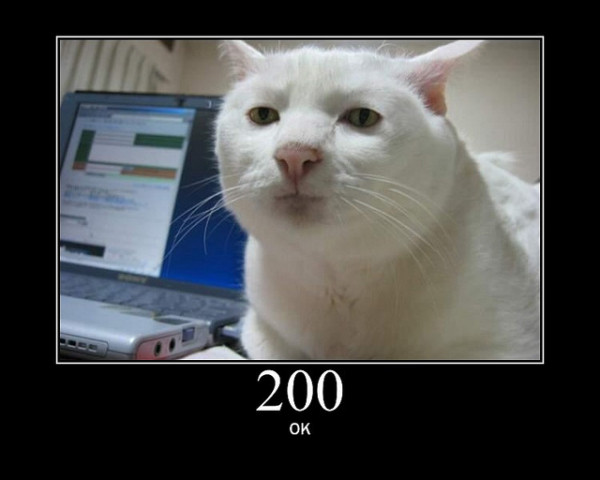
201 Created: Whether it’s a dinner or a diamond ring being discussed, the resource is being created. Pretty straightforward, and generally what we’d call a good day.

202 Accepted: This one just sounds good. Despite the success of your actual request, and the fact that you did receive an answer, it doesn’t really mean success. It’s more of a robot voiced, “Your proposal has been accepted.” It might or might not be processed. Those of you with children will be quite familiar with this, as it’s the standard parental response for almost anything a child asks.
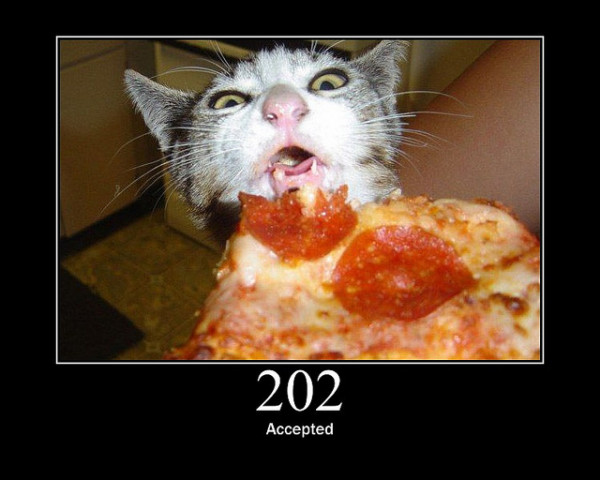
203 Non-Authoritative Information: Congratulations, you found one of the unicorns! You’re not likely to ever see this, or most of the other 200 Accepted range HTTP Status Codes listed here, but we don’t want to leave anything out. This means that the information may or may not be up to date, with the origin server defined as the authority. Local copies of information or non-authority responses are usually the cause of this.
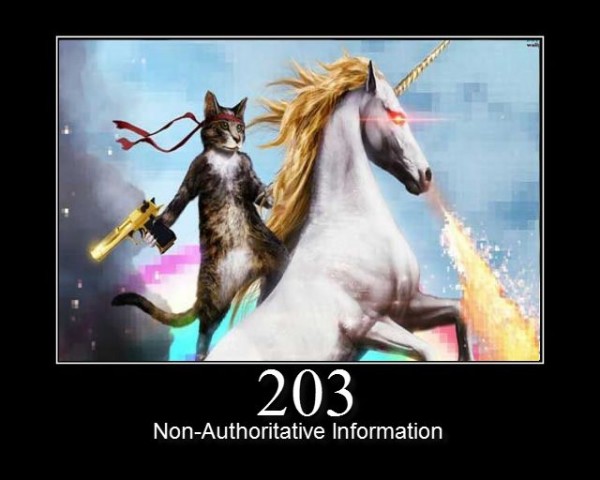
204 No Content: The server has done what was asked, but doesn’t need to respond. A bit like paying the bills, in which case the lights stay on, so no need to announce that you paid the bills. It was expected.
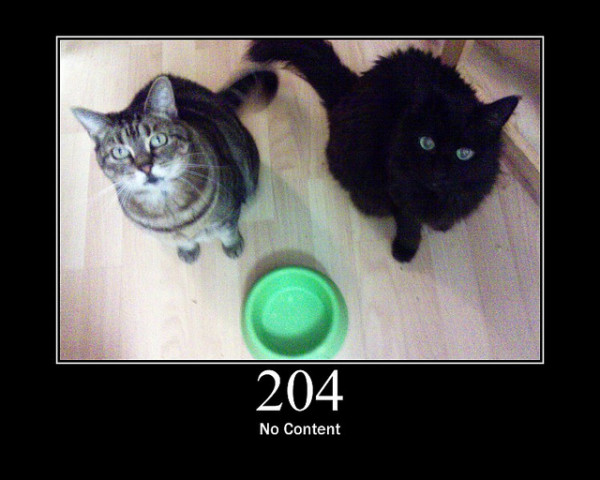
205 Reset Content: When you submit a form, this happens, and the form data is then reset to a default state. As a child, it’s also what happens every morning, when your mum manages to find the same porridge she’s been siphoning off Cthulhu to feed you for the last fifteen years. Lucky you.
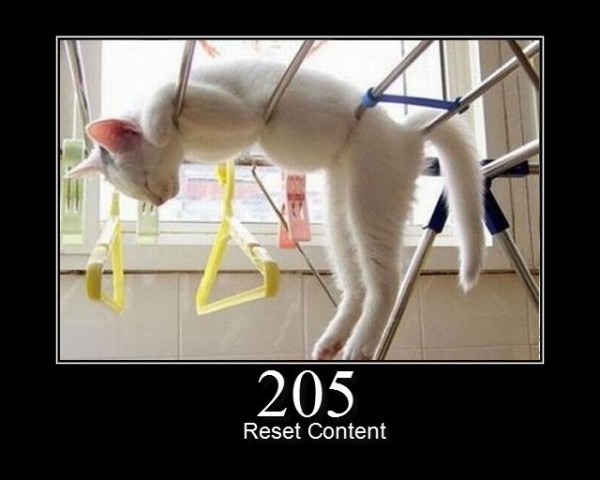
206 Partial Content: Designed to confuse those of us who aren’t programmers (and thank you, job well done chap), this means that the server has done part of what it was asked to do by the client. Could end well, as in you’re still shopping and just haven’t remembered that the whole reason you’re in the market is to get sugar. It could also end badly, as in you’ve just got home without the sugar, and are having the shopping list waved at you by an angry spouse.

207 Multi-Status: This is a situation where the server is confused and needs to consult with the client to get more information about what to process. The end result of this could be a success, failure or even a partial success. Just like when you give your spouse a long list of chores to do and they don’t even know where (or even how) to start.
208 Already Reported: You heard it once, you heard it twice and you don’t want to hear it again.
226 IM Used: Around 20 numbers later you end up with the 226 status code. You have finally done what you were asked, but depending on how you got here the result may differ.
Redirect (300 – 399)
These are all redirect codes. Generally, they mean that what was supposed to be there wasn’t, and so you’re being sent elsewhere to find it. It’s a bit like trying to buy something specific right before a holiday or asking for a steak in McDonalds. You’re likely to be redirected, and the destination of that redirection is what the SEO will want to be concerned with – specifically 301 and 302. All HTTP Status Codes in the Redirect range follow:
300 Multiple Choices: Because everyone loves not being told what to do, this option gives the agent or user one or more choices, depending on how its negotiated. A bit like life, though not as direct as some of the other options in this range of HTTP Status Codes.
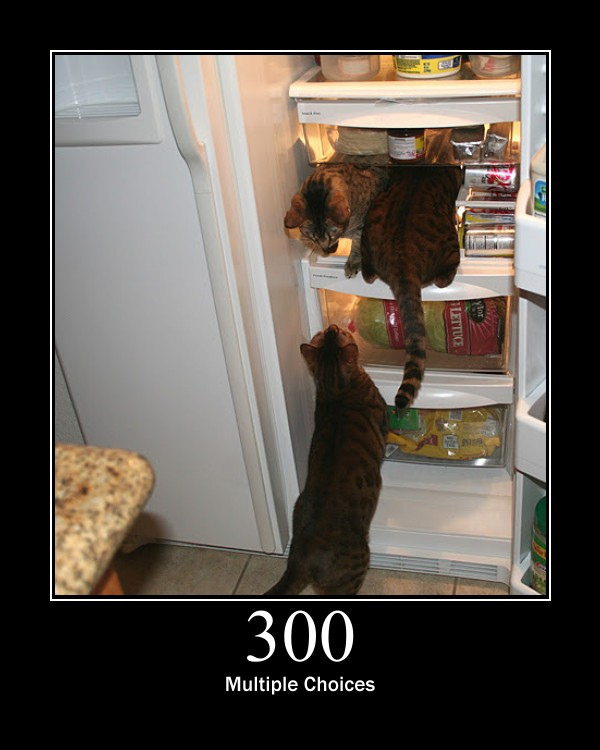
301 Moved Permanently: This is the bread and butter of SEO redirects. In simple terms, it’s like a mail forward. Everything that was coming to your old address is now sent to your new address. The best part of this one is that it lets you keep the link juice.
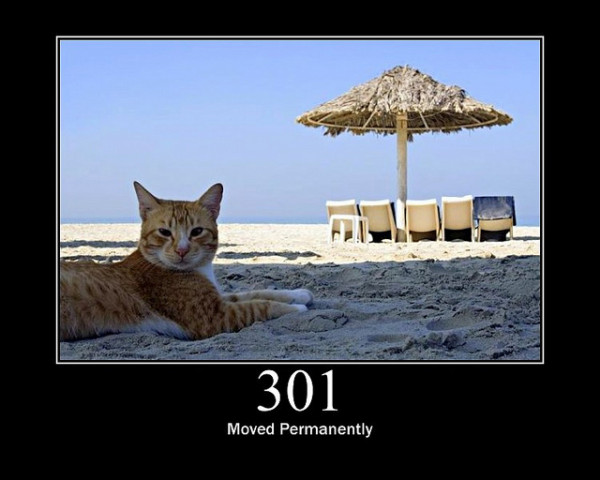
302 Found: For SEO purposes, this is not something you usually want to use unless it’s a temporary thing (like updating a resource, page, or link). Children are the best example of a 302 Redirect because when you ask them why their room is such a mess, they usually point out that they are using everything they’ve ever owned, and it’s only temporary.
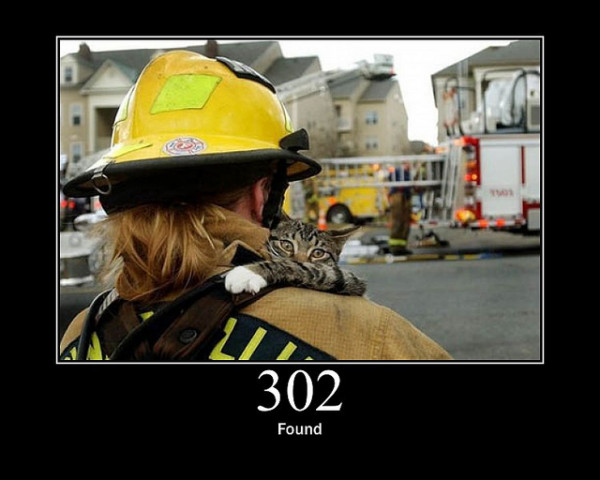
303 See Other: If you call to order a pizza, and after giving them your address, are transferred to the pizza place closer to your house, this has happened. It’s basically the same thing on the web, where submitting information gets you sent somewhere other than where you were headed.
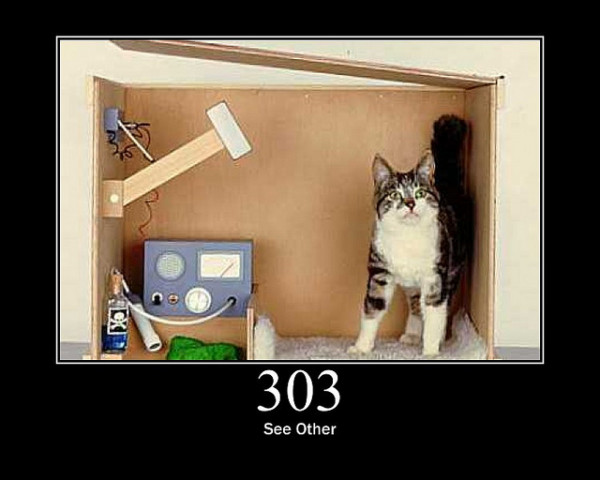
304 Not Modified: We’ll let you know if the situation changes. So will the website, in this case. In other words, nothing’s changed here.
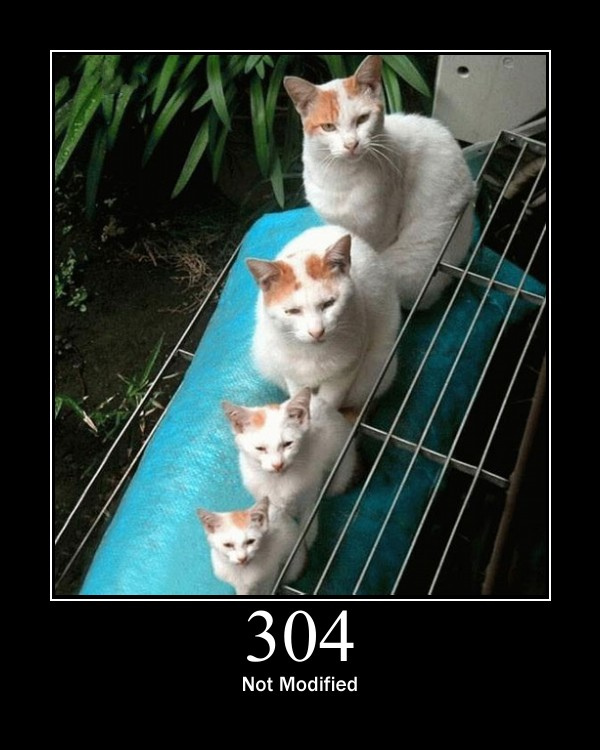
305 Use Proxy: This simply lets the requestor know that they need to use the proxy specified by the origin server. If that sounds confusing, think of it like opening a Flash website from your Android phone because it won’t open on an iPhone. You’ve just more or less used a proxy.
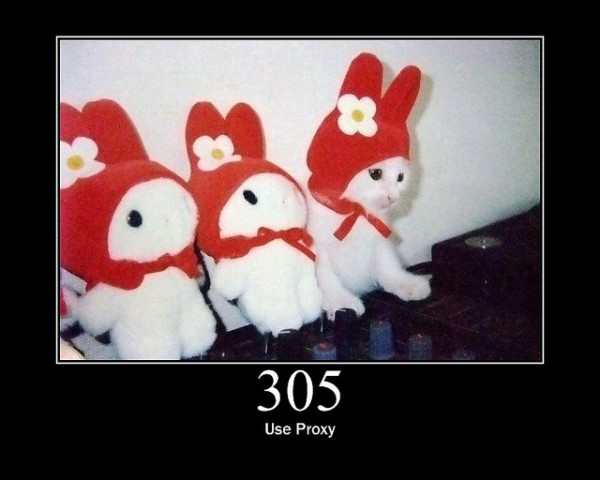
306 (Unused): This one is no longer used, but it is reserved for the day that… ah, I can’t tell you. You’ll just have to wait like the rest of us and see what lovely use this space gets put to in the future. Maybe it will start displaying Google AdSense or something equally exciting.
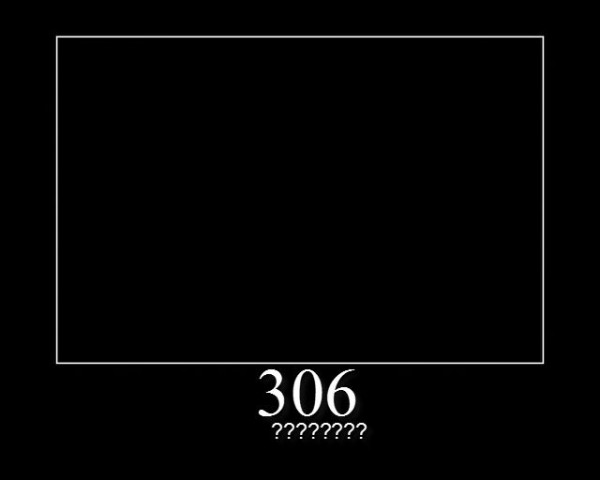
307 Temporary Redirect: This one simply means that you should repeat the same request with another URL. But in the future, this URL could still be used. It’s like temporarily closing your shop down for maintenance and telling your customers to go elsewhere for a short while until your shop is fixed.
308 Permanent Redirect: Similar to the above, but this time you’re closing your shop down for good.
Client Error (400 – 499)
The 400 series of error codes are very straightforward, but there are a lot of them. They basically mean that there was a mistake from the client (the person or robot browsing your site). For a nice mental image, think of it like that fellow you saw repeatedly pushing the door clearly labeled ‘pull’. Yeah. The range of Client Error HTTP Status Codes follows:
400 Bad Request: No speak-a-English? The server did not understand what was being asked. A no brainer, but asking the same way will return the same confused and blank stare from the server.
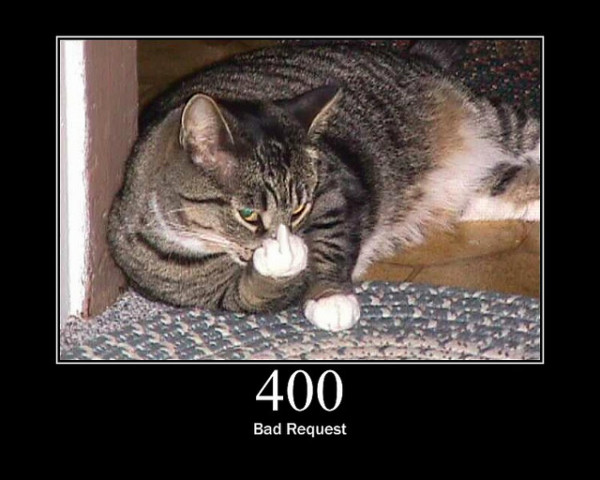
401 Unauthorized: This happens when you don’t know the magic word. In most cases, it’s not please.
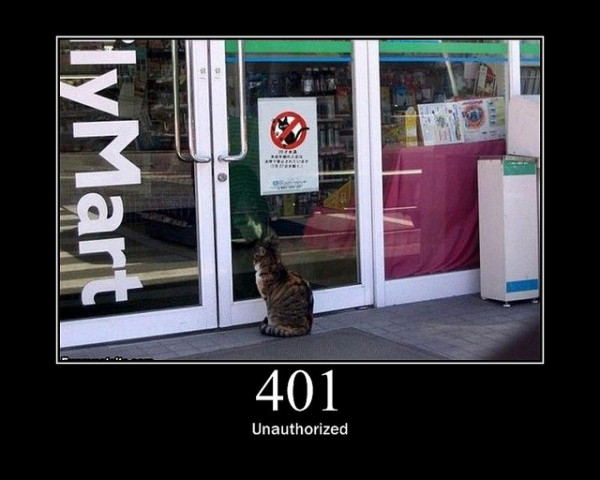
402 Payment Required: This code is not commonly used. But it’s pretty obvious that it’s used for payment gateways.
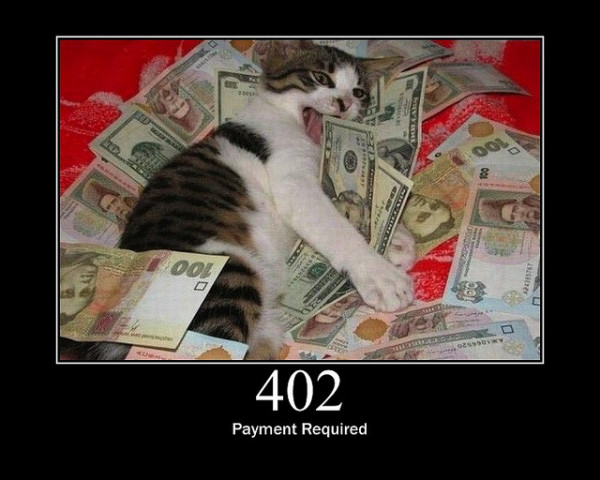
403 Forbidden: You are not allowed in, even if you know the password or have the keys to the castle. Ouch. Consider it an online face check. If you see this, you failed.
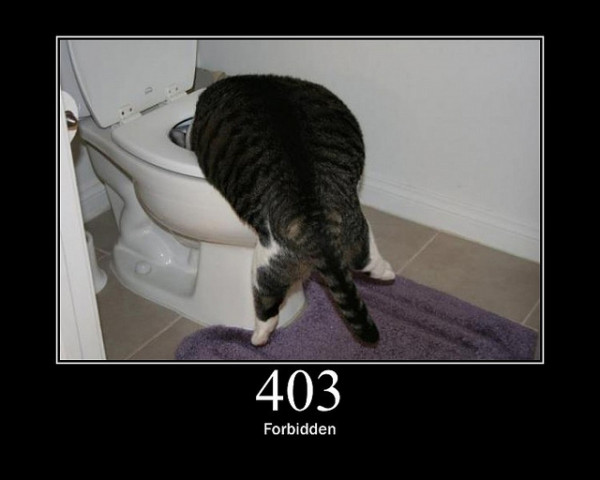
404 Not Found: Something a good SEO will pay attention to – because it might instead need to be a 301, or even a 410. Either way, there should always be something on a 404 page that lets the user head elsewhere on your site (to the home page, to another section – anywhere but another website, or you failed to convert that visitor). It’s also a bit like your significant other ‘not being in the mood’ – and can happen for server side reasons as well. Generally speaking, if you know that something isn’t there, 410 is the way to go.
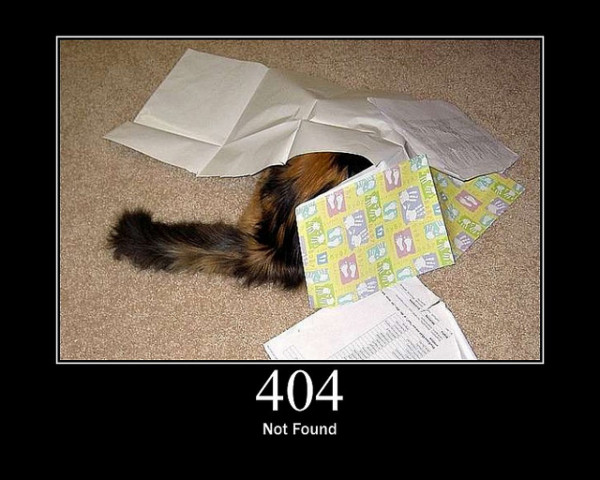
405 Method Not Allowed: You didn’t cut in front of everyone else, did you? Not allowed – back to the end of the queue buddy! Whatever you’re trying to do, it’s not allowed.
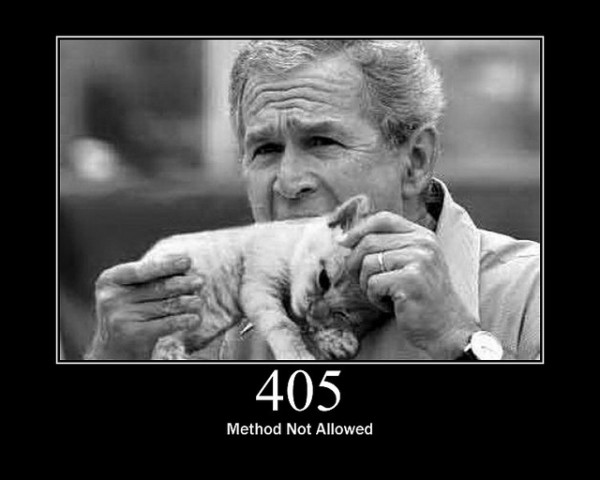
406 Not Acceptable: This one means that what you asked for can’t be provided according to the terms of your request. For example, you asked for water, either sparkling or flavored, but the waiter only has plain water. Not acceptable!
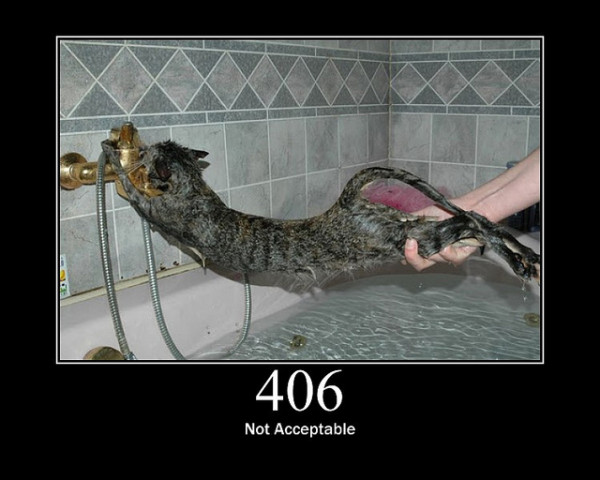
407 Proxy Authentication Required: In a word, you need to be authorized through the proxy in order to get in. A bit like standing in line outside of a club, only to find out that your name isn’t on the list. Better call your friend inside, or you aren’t getting in.
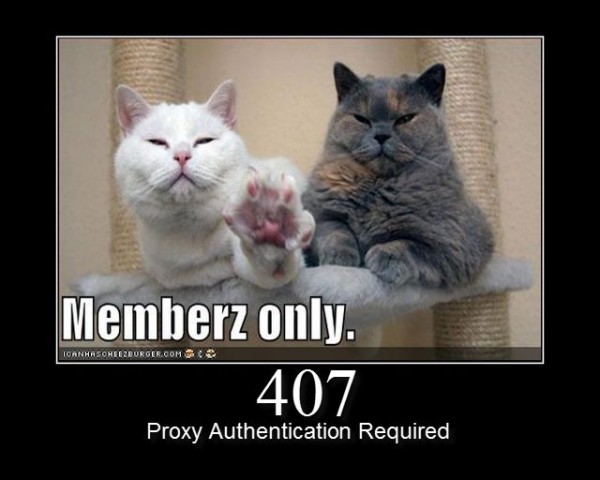
408 Request Time Out: You took longer than the server was willing to wait. You can bugger off now.
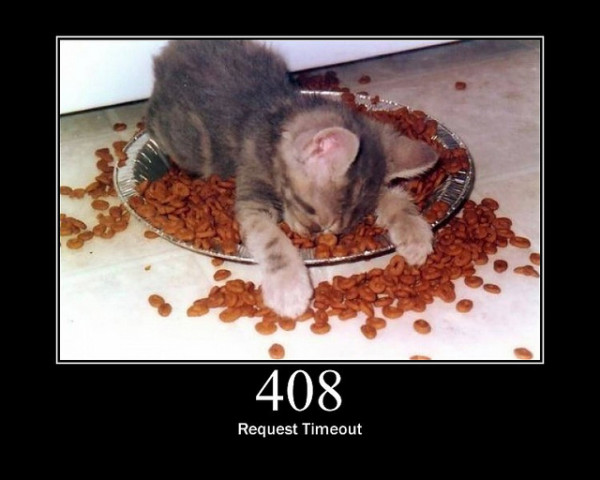
409 Conflict: Your wife found out about your fascination with Beyoncé. Fortunately for you, this code is only allowed when there is something the user can do to remedy the situation (now we’re back to putting a ring on it).
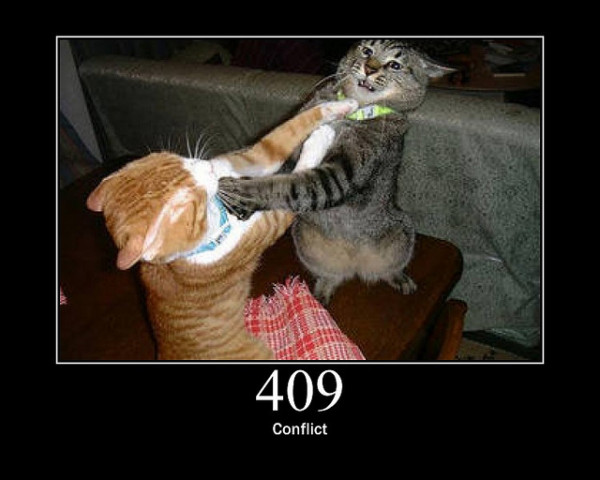
410 Gone: My favorite, as it neatly summarizes the entire Zen of SEO Redirects in one word. Gone. It means that whatever you were looking for is permanently gone. This is a bread and butter HTTP Status Code for the aspiring SEO. It’s especially effective at letting people know they should stop linking to limited time things, like promotions, or contests, as an example. You should also note that the same thing happens to your money when you visit a casino.

411 Length Required: This means that the client request needs to meet the required length. It is also a problem suffered by men all over the world.

412 Precondition Failed: This happens when you failed to meet the requirements set on the server to access a particular resource. It also happens when asking a member of the opposite sex out on a date if you aren’t good looking enough, or not willing to spend enough money.
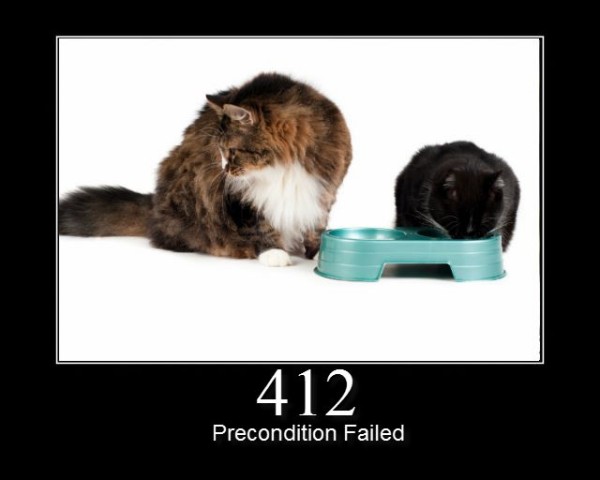
413 Request Entity Too Large: This happens when there is just too much for the server to handle. However, according to online research, this is something most of the world doesn’t consider to be a problem.
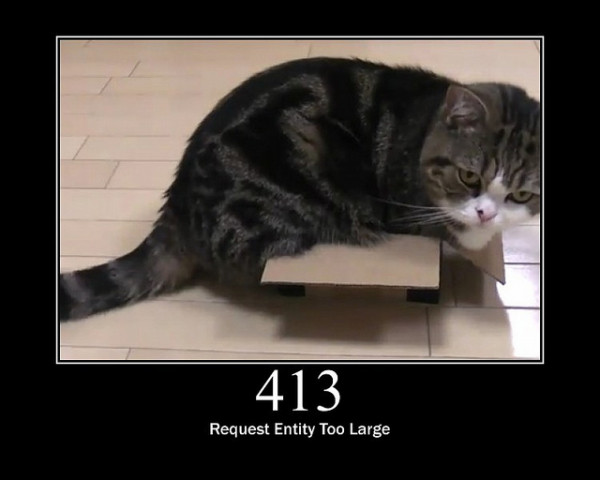
414 Request URI Too Long: Like the HTTP Status Code 413 above, much of the world does not actually consider it to be a problem. However, the W3C does acknowledge that this is a rare condition. Direct from the pages of the W3C, “This rare condition is only likely to occur when a client has improperly…” I swear I’m not making that up.
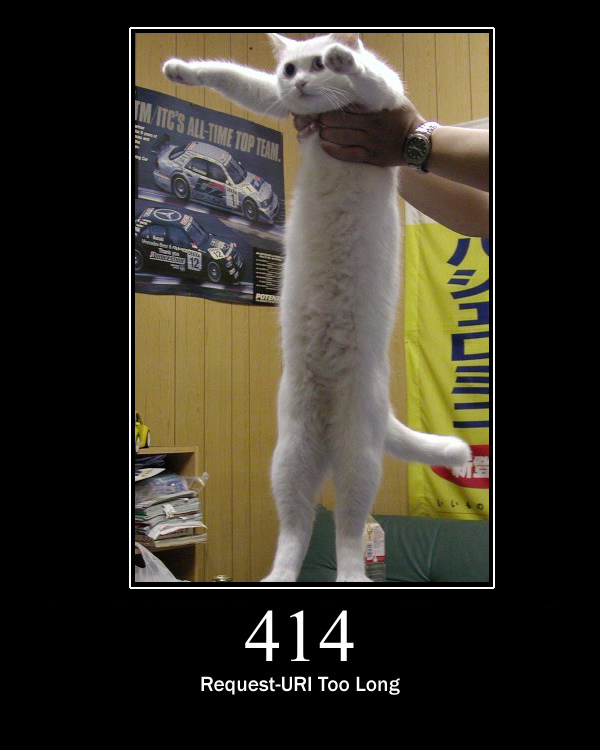
415 Unsupported Media Type: This happens when you try to put a cassette tape into a CD player.
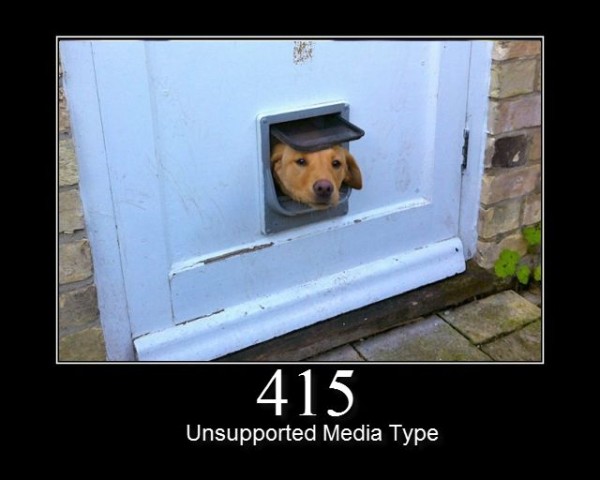
416 Requested Range Not Satisfiable: This is what you say when you can’t do what’s being asked for the amount the person asking is willing to pay. It’s pretty much the same response the server gives.
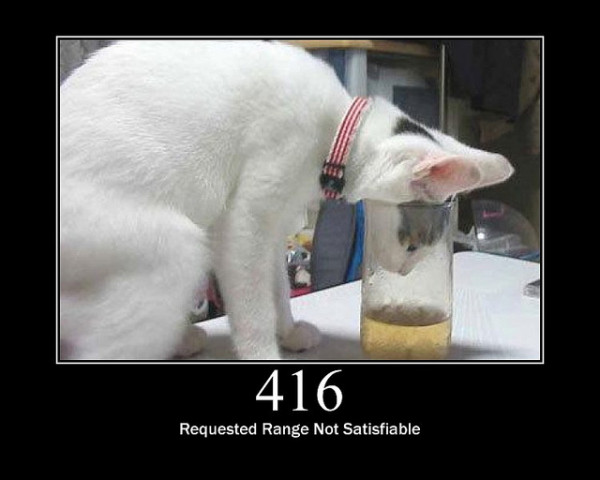
417 Expectation Failed: Marriage counselors hear this a lot, although, it’s even more commonly heard in divorce court. If the server tells you this, sorry man, but it’s over.
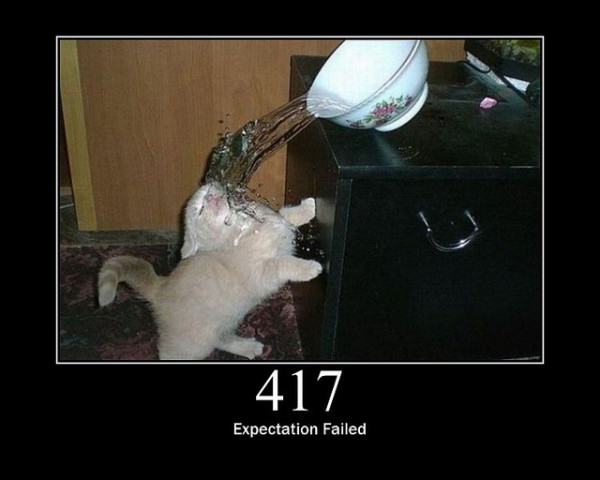
Server Error (500 – 599)
This is what happens when the server has an error. In some cases, it can be because the server is offline, but there are other causes, such as a SQL cluster failing, or particular resources not being accessible. In any case, HTTP Status Codes that are in the Server Error range include:
500 Internal Server Error: This is what happens when the server has a problem, but isn’t being more specific about it. It also happens when a man is lost, but refuses to admit it or ask for directions.
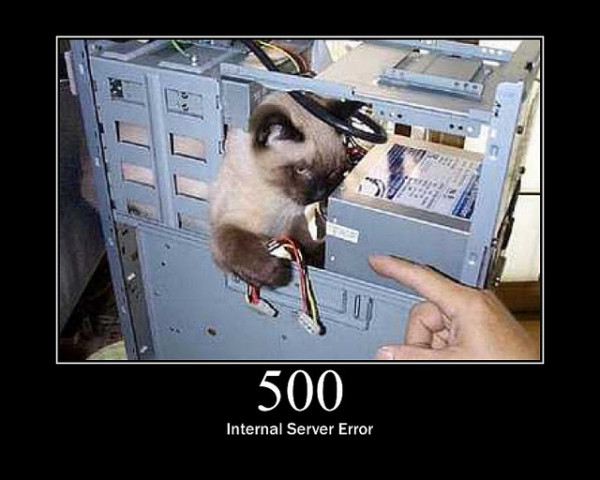
501 Not Implemented: Whatever you’re asking the server to do, it can’t. Put another way, round pegs don’t go in square holes.
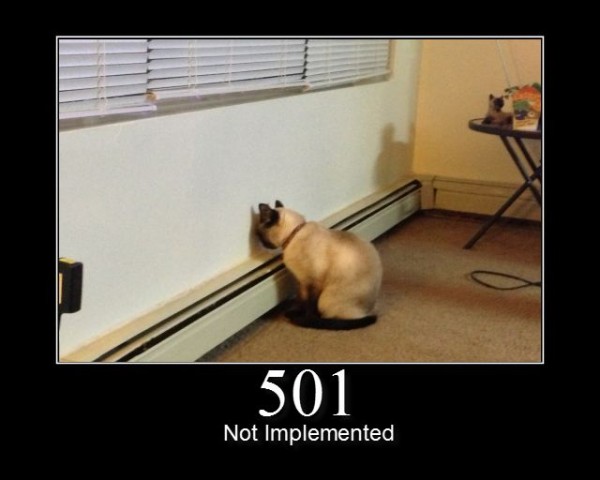
502 Bad Gateway: You asked the server to do something that required asking other servers to assist. Somewhere along the way, it didn’t get help, and the request failed. A lot like that friend you have, who has a friend with a truck, and will totally help you move, except, no one ever shows up.
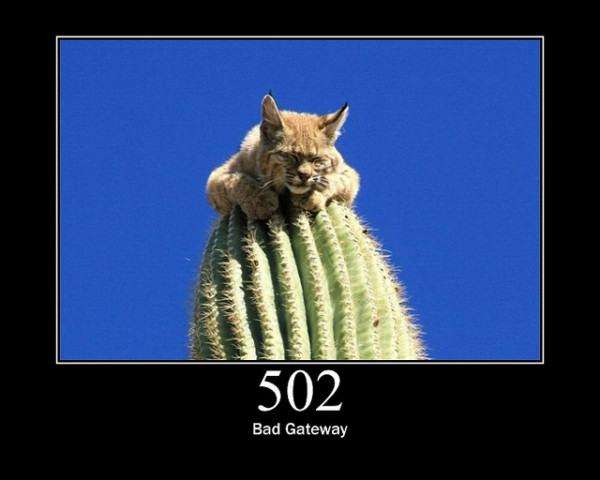
503 Service Unavailable: This one isn’t used that often, but it means the server is unable to do what you’ve asked – usually because it’s overloaded. If shared hosts, like Bluehost, were honest, you’d probably see a lot more of this.
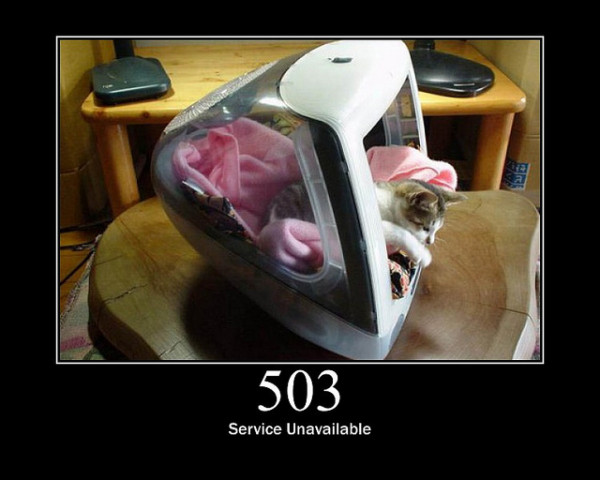
504 Gateway Timeout: Similar to 502, but in this case the upstream server took too long to answer. Ironically, this is the same excuse your friend with the friend with the truck will use when explaining why he disappeared on moving day, but managed to come to your housewarming party for free drinks. Funny how that works.
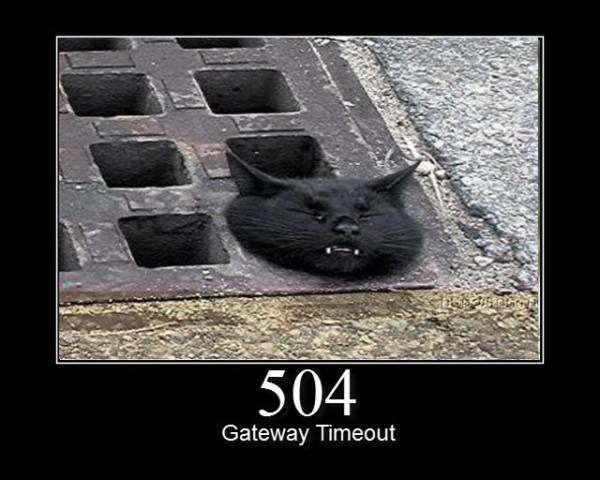
505 HTTP Version Not Supported: This happens when, for whatever reason, your server won’t support the HTTP version that was used by the client when making their request. It’s a bit like trying to go back to being ‘boyfriend girlfriend’ when you’re married. It just doesn’t work. Servers have an HTTP requirement, and marriages have a back or foot rub requirement.
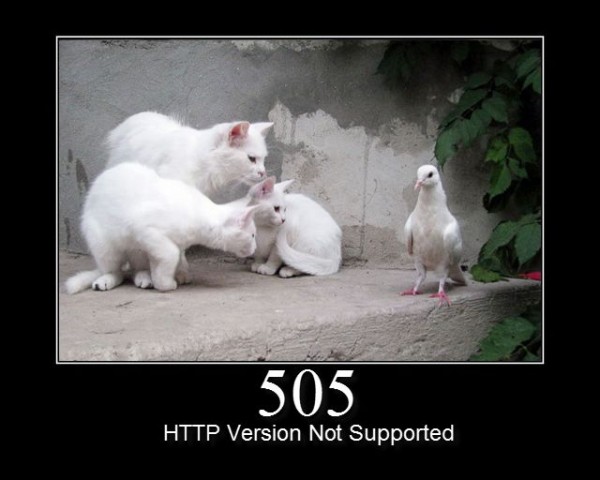
Summary
So, there you have the list of HTTP Status Codes, and more or less what they mean. If you’d like to see all of the other codes that are out there, Wikipedia has a great page for that, which lists a whole host of other codes that aren’t really mainstream. Most notable are those defined by the HTCPCP Standards (http://en.wikipedia.org/wiki/Hyper_Text_Coffee_Pot_Control_Protocol) which famously listed the Error Code 418 I’m A Teapot, but there are others. It’s particularly funny because everyone knows we drink coffee, and of course a teapot would… uh… Right? Hello?
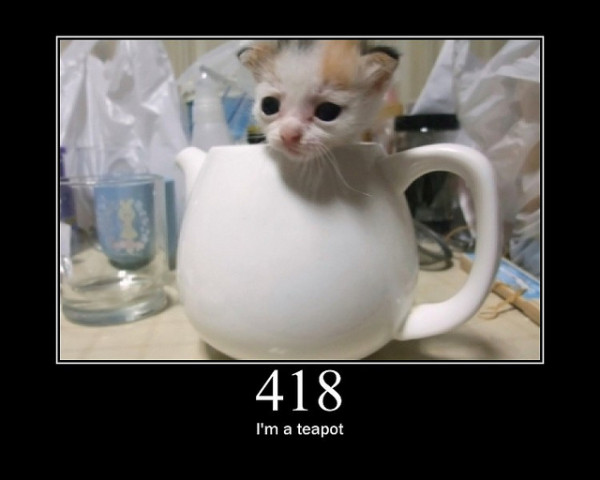
(p.s all Cat pictures used under Creatives common license and with thanks to Girlie Mac)
2 января, 2015 12:50 пп
15 441 views
| Комментариев нет
Cloud Server
При обращении к веб-серверу или приложению каждый поступивший HTTP-запрос получает в качестве ответа код состояния HTTP (англ. HTTP status code). Коды состояния HTTP – это трехзначные коды, сгруппированные в пять различных классов. Класс кода состояния можно определить по первой цифре:
- 1хх – информационные коды;
- 2хх – успех;
- 3хх – перенаправление;
- 4хх – ошибка клиента;
- 5хх – ошибка сервера.
Это руководство фокусируется на выявлении и устранении наиболее часто встречающихся кодов ошибок HTTP (то есть кодов состояния 4xx и 5xx) с точки зрения системного администратора. В некоторых ситуациях веб-сервер отвечает на запрос определенным кодом ошибки; рассмотрим общие возможные причины и решения.
Краткий обзор ошибок клиента и сервера
Ошибки клиента (коды состояния HTTP 400-499) возникают из-за HTTP-запросов, отправленных клиентом (веб-браузером или другим клиентом HTTP). Хотя данные типы ошибок связаны непосредственно с клиентом, системному администратору полезно знать, с какими кодами ошибок может столкнуться пользователь, чтобы определить, можно ли решить эту проблему в конфигурациях сервера.
Ошибки сервера (коды состояния HTTP 500-599) возникают тогда, когда веб-сервер не в состоянии обработать запрос из-за какой-либо ошибки или сбоя.
Общие советы по устранению ошибок HTTP
- При использовании веб-браузера для тестирования веб-сервера не забудьте обновить браузер после внесения изменений в настройки сервера.
- Проверяйте логи сервера, чтобы получить подробные сведения о том, как сервер обрабатывает запросы. Например, веб-серверы Apache и Nginx создают два файла по имени access.log и error.log, в которых можно найти соответствующую информацию.
- Запомните: определения кодов состояния HTTP являются частью стандарта, который реализуется обслуживающим запросы приложением. Это означает, что фактический код состояния, который возвращается в результате, зависит от того, как программное обеспечение сервера обрабатывает конкретную ошибку.
Ознакомившись с основными понятиями кодов состояния HTTP, приступим к обзору наиболее часто встречающихся ошибок.
Ошибка 400 Bad Request
Код статуса 400, или ошибка Bad Request («неверный запрос») означает, что синтаксис запроса HTTP, отправленного на сервер, неверен.
Как правило, причины возникновения ошибки 400 Bad Request таковы:
- Куки пользователя, связанные с сайтом, повреждены. Чтобы решить эту проблему,, попробуйте очистить кэш браузера и файлы cookie.
- Искаженный запрос из-за неисправного браузера.
- Искаженный запрос из-за ошибки пользователя при формировании HTTP-запроса вручную (например, неправильное использование curl).
Ошибка 401 Unauthorized
Код статуса 401, или ошибка Unauthorized («неавторизован») значит, что пользователь, пытающийся получить доступ к ресурсу, не прошел авторизацию (или не смог пройти ее, указав неверные учетные данные). Чтобы иметь возможность просматривать защищенный ресурс, пользователь должен предоставить корректные учетные данные.
Например, ошибка 401 Unauthorized может возникнуть, если пользователь пытается получить доступ к ресурсу, который защищен HTTP-авторизацией (как в этом руководстве по Nginx). В подобной ситуации ошибка 401 будет появляться снова и снова до тех пор, пока пользователь не предоставит корректный логин и пароль (который внесен в файл .htpasswd).
Ошибка 403 Forbidden
Код состояния 403, или ошибка Forbidden («запрещено») значит, что запрос пользователя был отправлен верно, но сервер отказывается обслуживать его в связи с отсутствием разрешения на доступ к запрашиваемому ресурсу. В этом разделе описаны наиболее распространенные причины возникновения ошибки 403.
Права на файл
Как правило, ошибка 403 случается, если пользователь, который запускает процесс веб-сервера, не имеет прав на чтение запрашиваемого файла.
Чтобы привести пример устранения ошибки 403, предположим, что:
- пользователь пытается получить доступ к индексному файлу (http://example.com/index.html);
- рабочий процесс веб-сервера принадлежит пользователю www-data;
- индексный файл на сервере находится в /usr/share/nginx/html/index.html.
Итак, если пользователь получает ошибку 403 Forbidden, убедитесь, что пользователь www-data имеет права на чтение файла. Как правило, в подобной ситуации нужно просто изменить права на файл. Это можно сделать несколькими способами, но в данном случае подойдет вот эта команда:
sudo chmod o=r /usr/share/nginx/html/index.html
Файл .htaccess
Еще одна потенциальная причина возникновения ошибки 403 (часто это делается намеренно) – использование файла .htaccess. При помощи файла .htaccess можно запретить конкретным IP-адресам (или диапазонам адресов) доступ к определенным ресурсам.
Если пользователи неожиданно получают ошибку 403 Forbidden, убедитесь, что она не была вызвана настройками файла .htaccess.
Несуществующий индексный файл
Если пользователь пытается получить доступ к каталогу, который не имеет стандартного индексного файла, а листинг каталога (directory listing) отключен, веб-сервер будет возвращать ошибку 403 Forbidden. Такое случится, если, например, пользователь попытается получить доступ к каталогу http://example.com/emptydir/, а в каталоге emptydir на сервере нет индексного файла. Листинг каталога можно включить в конфигурациях сервера.
Ошибка 404 Not Found
Код статуса 404, или ошибка Not Found («не найдено») значит, что пользователь может взаимодействовать с сервером, но требуемый файл или ресурс отсутствует.
Ошибки 404 могут возникнуть в самых различных ситуациях. Ниже приведен список советов, которые помогут устранить проблему в случае, если пользователь неожиданно получил 404 Not Found:
- Проверьте ссылку, которая направляет пользователя на сервер, на наличие ошибок или опечаток.
- Возможно, пользователь ввел неверный URL.
- Может быть, нужного файла не существует в указанном месте на сервере; убедитесь, что запрашиваемый ресурс не был перемещен или удален с сервера.
- Проверьте, правильно ли указано местонахождение корневого каталога (document root) в конфигурации сервера.
- Возможно, пользователь, которому принадлежит рабочий процесс веб-сервера, не имеет соответствующих прав, чтобы открыть каталог, в котором находится запрашиваемый файл. Для доступа к каталогу нужны права на чтение и выполнение.
- Если пользователь переходит к ресурсу по символической ссылке, убедитесь, что веб-сервер настроен для поддержки символических ссылок.
Ошибка 500 Internal Server Error
Код состояния 500, или ошибка Internal Server Error («внутренняя ошибка сервера») означает, что сервер не может обработать запрос по неизвестной причине. Иногда этот код появляется в ситуациях, когда более подходящими являются другие сообщения об ошибках 5xx.
Как правило, причиной данной ошибки является неправильная настройка сервера (например, искаженный файл .htaccess) или нехватка некоторых пакетов (к примеру, запуск файла PHP без предварительно установленного PHP).
Ошибка 502 Bad Gateway
Код состояния 502, или ошибка Bad Gateway («ошибочный шлюз») значит, что запрашиваемый сервер является шлюзом или прокси-сервером, и он не получает валидных ответов от серверов бэкэнда, которые на самом деле выполнили запрос.
Если речь идет об обратном прокси-сервере (например, о балансировщике нагрузки), убедитесь, что:
- с серверами бэкэнда (на которые пересылаются HTTP-запросы) все в порядке;
- обратный прокси настроен правильно, в его настройках указаны корректные бэкэнды;
- сетевое соединение между серверами бэкэнда и обратным прокси-сервером в порядке. Если серверы могут взаимодействовать на других портах, убедитесь, что эти порты не заблокированы брандмауэром;
- нужные сокеты существуют в корректном местонахождении и имеют соответствующие разрешения (если веб-приложение настроено слушать сокеты).
Ошибка 503 Service Unavailable
Код состояния 503, или ошибка Service Unavailable («сервис недоступен») означает, что сервер перегружен или находится на обслуживании; такой сервис должен стать доступным в течение некоторого времени.
Если сервер не находится на обслуживании, эта ошибка может указывать на то, что серверу не хватает ресурсов процессора или памяти для обработки всех входящих запросов, или что нужно настроить веб-сервер для обслуживания большего количества пользователей или процессов.
Ошибка 504 Gateway Timeout
Код состояния 504, или ошибка Gateway Timeout («шлюз не отвечает») значит, что данный сервер является шлюзом или прокси-сервером, и он не получает ответа от бэкэнда в пределах допустимого периода времени.
Как правило, это происходит по следующим причинам:
- Плохое сетевое соединение между серверами;
- Внутренний сервер, который выполняет запрос, работает слишком медленно;
- В настройках сервера задано слишком короткое время ожидания шлюза или прокси-сервера.
Заключение
Теперь вы знакомы с основными кодами ошибок HTTP и знаете некоторые пути решения этих проблем.
Если же вы столкнулись с ошибкой, которая не была охвачена данной статьей, или знаете другие удобные способы устранения ошибок HTTP, пожалуйста, опишите их в комментариях ниже.
Tags: Cloud Server, HTTP, HTTP status code, VPS
HTTP status codes are like short notes from a server that get tacked onto a web page. They’re not actually part of the site’s content. Instead, they’re messages from the server letting you know how things went when it received the request to view a certain page.
These kinds of messages are returned every time your browser interacts with a server, even if you don’t see them. If you’re a website owner or developer, understanding HTTP status codes is critical. When they do show up, HTTP status codes are an invaluable tool for diagnosing and fixing website configuration errors.
This article introduces several server status and error codes, and explains what they reveal about what’s happening on the server behind the scenes.
Let’s dive in!
Prefer to watch the video version?
What Are HTTP Status Codes?
Every time you click on a link or type in a URL and press Enter, your browser sends a request to the webserver for the site you’re trying to access. The server receives and processes the request, and then sends back the relevant resources along with an HTTP header.
HTTP status codes are delivered to your browser in the HTTP header. While status codes are returned every single time your browser requests a web page or resource, most of the time you don’t see them.
It’s usually only when something goes wrong that you might see one displayed in your browser. This is the server’s way of saying: “Something isn’t right. Here’s a code that explains what went wrong.”

If you want to see the status codes that your browser doesn’t normally show you, there are many different tools that make it easy. Browser extensions are available for developer-friendly platforms such as Chrome and Firefox, and there are many web-based header fetching tools like Web Sniffer.
To see HTTP status codes with one of these tools, look for the line appearing near the top of the report that says “Status: HTTP/1.1”. This will be followed by the status code that was returned by the server.
Understanding HTTP Status Code Classes
HTTP status codes are divided into 5 “classes”. These are groupings of responses that have similar or related meanings. Knowing what they are can help you quickly determine the general substance of a status code before you go about looking up its specific meaning.
The five classes include:
- 100s: Informational codes indicating that the request initiated by the browser is continuing.
- 200s: Success codes returned when browser request was received, understood, and processed by the server.
- 300s: Redirection codes returned when a new resource has been substituted for the requested resource.
- 400s: Client error codes indicating that there was a problem with the request.
- 500s: Server error codes indicating that the request was accepted, but that an error on the server prevented the fulfillment of the request.
Within each of these classes, a variety of server codes exist and may be returned by the server. Each individual code has a specific and unique meaning, which we’ll cover in the more comprehensive list below.
Why HTTP Status Codes and Errors Matter for Search Engine Optimization (SEO)
Search engine bots see HTTP status codes while they’re crawling your site. In some cases, these messages can influence if and how your pages get indexed, as well as how search engines perceive the health of your site.
Generally speaking, 100- and 200-level HTTP status codes won’t have much impact on your SEO. They signal that everything is working as it should on your site, and enable search engine bots to continue on their way. However, they aren’t going to boost your rankings either.
For the most part, it’s the higher-level codes that matter for SEO. 400- and 500-level responses can prevent bots from crawling and indexing your pages. Too many of these errors can also indicate that your site isn’t of high quality, possibly lowering your rankings.
300-level codes have a bit more complicated relationship with SEO. The main thing you need to know to understand their impact is the difference between permanent and temporary redirects, which we’ll cover in more detail in the relevant section below.
In a nutshell, however, permanent redirects share link equity from backlinks, but temporary ones do not. In other words, when you use temporary redirects for pages that have moved, you lose the SEO advantage of all the link building you’ve done.
Checking for HTTP Status Codes in Google Search Console
One way to monitor how Google perceives the HTTP status codes on your site is to use Google Search Console. You can view 300-, 400-, and 500-level status codes in the Coverage report:

This area of your dashboard shows four types of content on your site:
- Pages that return errors.
- Valid pages that have warnings.
- Resources that are valid.
- Content excluded from the index.
You may find pages with 300-, 400-, and 500-level HTTP status codes under the Excluded, Error, or Valid with warnings sections, depending on the type of code. For instance, 301 redirects may be listed under Excluded as Page with redirect:
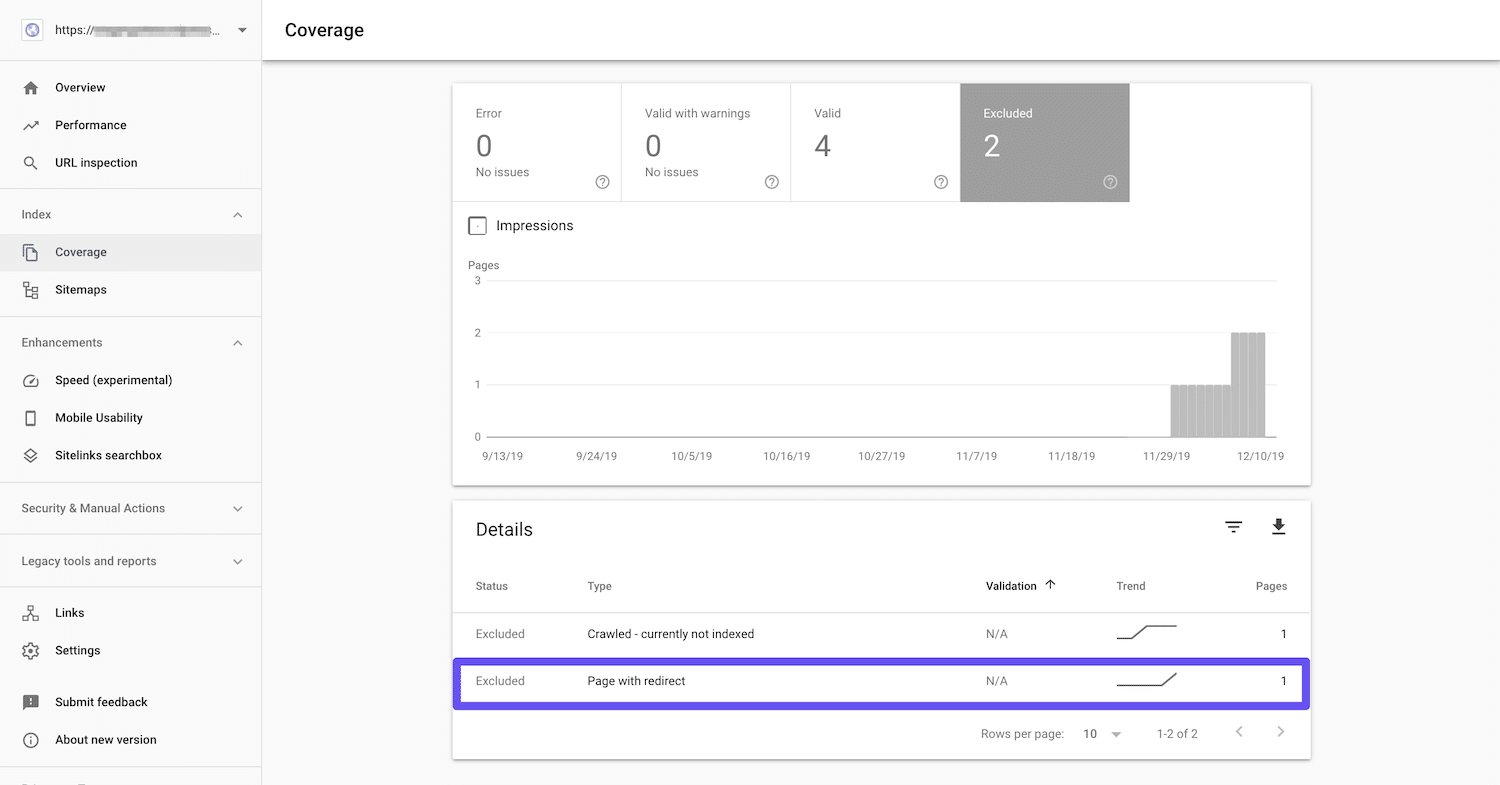
400- and 500-level status codes will likely turn up under Error.
Another way to view HTTP status codes is by using the URL Inspection tool. If Google is unable to index a specific page due to an error, you’ll see that here:
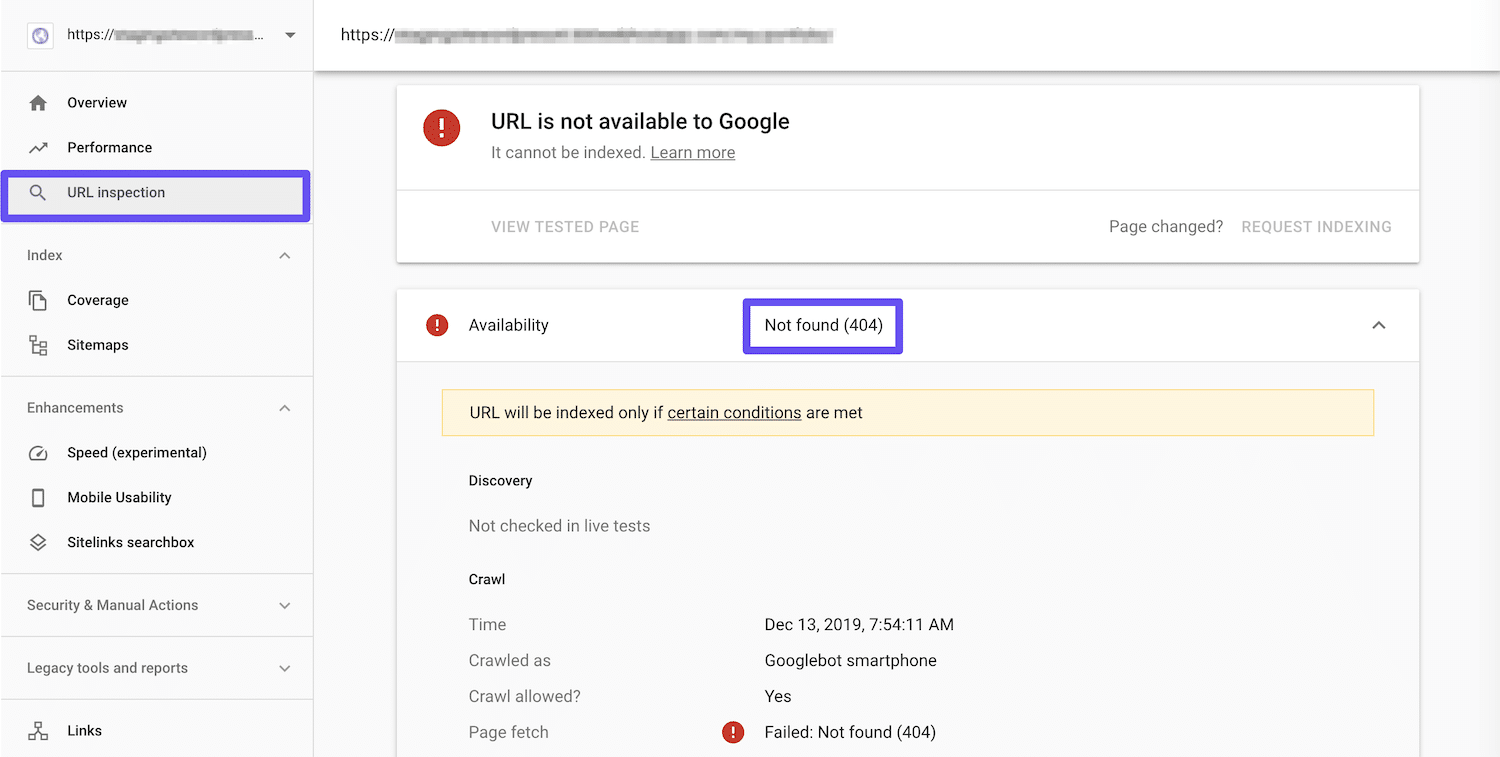
For more tips on using Google Search Console, check out our comprehensive guide to the platform.
A Complete Guide and List of HTTP Status Codes
While there are over 40 different server status codes, you’ll likely encounter fewer than a dozen on a regular basis. Below, we’ve covered the more common ones, as well as a few of the more obscure codes you may still run across.
100 Status Codes
A 100-level status code tells you that the request you’ve made to the server is still in progress for some reason. This isn’t necessarily a problem, it’s just extra information to let you know what’s going on.
- 100: “Continue.” This means that the server in question has received your browser’s request headers, and is now ready for the request body to be sent as well. This makes the request process more efficient since it prevents the browser from sending a body request even though the headers have been rejected.
- 101: “Switching protocols.” Your browser has asked the server to change protocols, and the server has complied.
- 103: “Early hints.” This returns some response headers before the rest of the server’s response is ready.
200 Status Codes
This is the best kind of HTTP status code to receive. A 200-level response means that everything is working exactly as it should.
- 200: “Everything is OK.” This is the code that is delivered when a web page or resource acts exactly the way it’s expected to.
- 201: “Created.” The server has fulfilled the browser’s request, and as a result, has created a new resource.
- 202: “Accepted.” The server has accepted your browser’s request but is still processing it. The request ultimately may or may not result in a completed response.
- 203: “Non-Authoritative Information.” This status code may appear when a proxy is in use. It means that the proxy server received a 200 “Everything is OK” status code from the origin server, but has modified the response before passing it on to your browser.
- 204: “No Content.” This code means that the server has successfully processed the request, but is not going to return any content.
- 205: “Reset Content.” Like a 204 code, this means that how server has processed the request but is not going to return any content. However, it also requires that your browser resets the document view.
- 206: “Partial Content.” You may see this status code if your HTTP client (also known as your browser) uses ‘range headers’. This enables your browser to resume paused downloads, as well as to split a download into multiple streams. A 206 code is sent when a range header causes the server to send only part of the requested resource.
300 Status Codes
Redirection is the process used to communicate that a resource has been moved to a new location. There are several HTTP status codes that accompany redirections, in order to provide visitors with information about where to find the content they’re looking for.
- 300: “Multiple Choices.” Sometimes, there may be multiple possible resources the server can respond with to fulfill your browser’s request. A 300 status code means that your browser now needs to choose between them. This may occur when there are multiple file type extensions available, or if the server is experiencing word sense disambiguation.
- 301: “The requested resource has been moved permanently.” This code is delivered when a web page or resource has been permanently replaced with a different resource. It is used for permanent URL redirection.
- 302: “The requested resource has moved, but was found.” This code is used to indicate that the requested resource was found, just not at the location where it was expected. It is used for temporary URL redirection.
- 303: “See Other.” Understanding a 303 status code requires that you know the difference between the four primary HTTP request methods. Essentially, a 303 code tells your browser that it found the resource your browser requested via POST, PUT, or DELETE. However, to retrieve it using GET, you need to make the appropriate request to a different URL than the one you previously used.
- 304: “The requested resource has not been modified since the last time you accessed it.” This code tells the browser that the resources stored in the browser cache haven’t changed. It’s used to speed up web page delivery by reusing previously-downloaded resources.
- 307: “Temporary Redirect.” This status code has replaced 302 “Found” as the appropriate action when a resource has been temporarily moved to a different URL. Unlike the 302 status code, it does not allow the HTTP method to change.
- 308: “Permanent Redirect.” The 308 status code is the successor to the 301 “Moved Permanently” code. It does not allow the HTTP method to change and indicates that the requested resource is now permanently located at a new URL.
400 Status Codes
At the 400 level, HTTP status codes start to become problematic. These are error codes specifying that there’s a fault with your browser and/or request.
- 400: “Bad Request.” The server can’t return a response due to an error on the client’s end. See our guide for resolving this error.
- 401: “Unauthorized” or “Authorization Required.” This is returned by the server when the target resource lacks valid authentication credentials. You might see this if you’ve set up basic HTTP authentication using htpasswd.
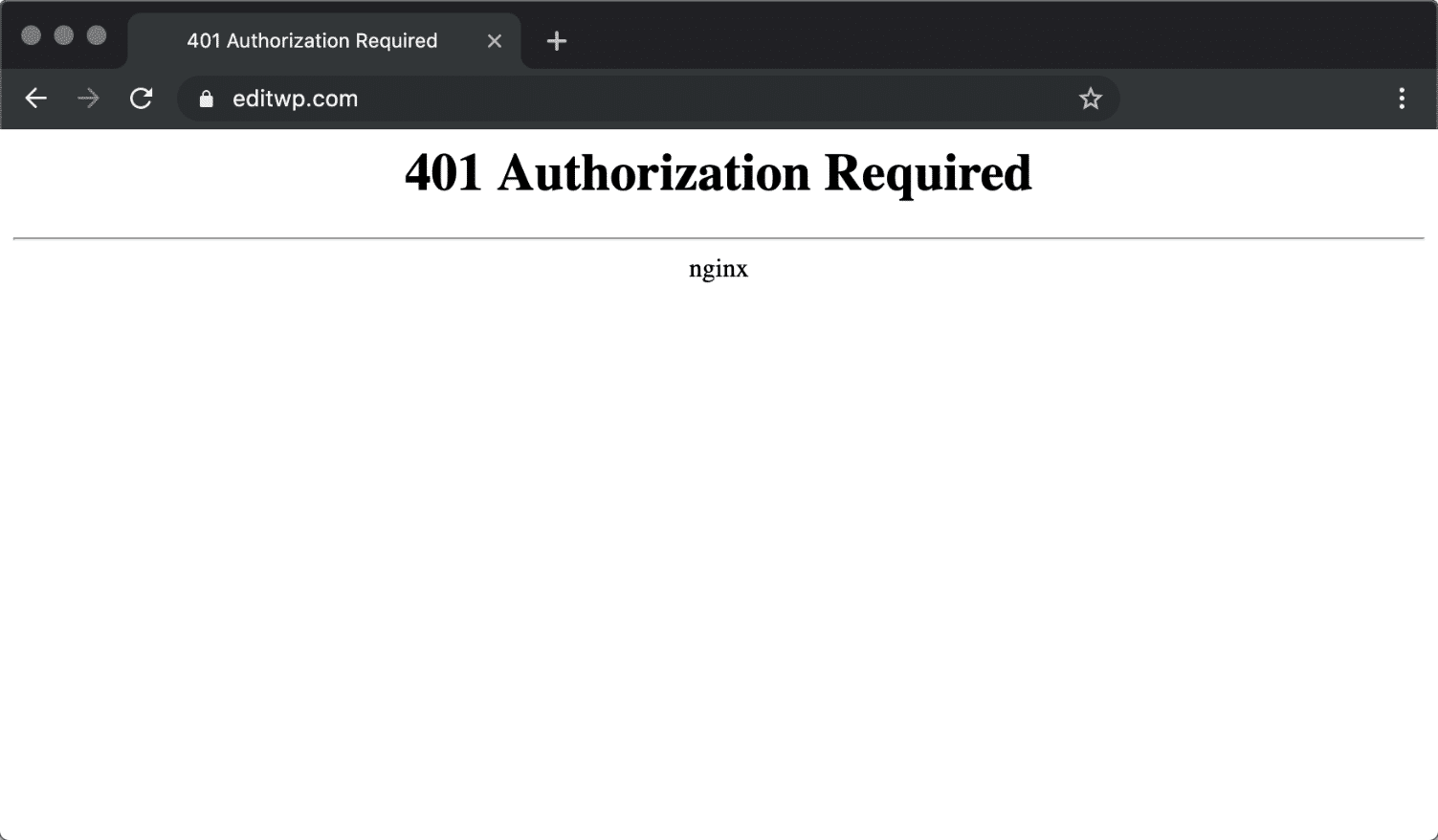
- 402: “Payment Required.” Originally, this code was created for use as part of a digital cash system. However, that plan never followed through. Instead, it’s used by a variety of platforms to indicate that a request cannot be fulfilled, usually due to a lack of required funds. Common instances include:
- You’ve reached your daily request limit to the Google Developers API.
- You haven’t paid your Shopify fees and your store has been temporarily deactivated.
- Your payment via Stripe has failed, or Stripe is trying to prevent a fraudulent payment.
- 403: “Access to that resource is forbidden.” This code is returned when a user attempts to access something that they don’t have permission to view. For example, trying to reach password-protected content without logging in might produce a 403 error.
- 404: “The requested resource was not found.” This is the most common error message of them all. This code means that the requested resource does not exist, and the server does not know if it ever existed.
- 405: “Method not allowed.” This is generated when the hosting server (origin server) supports the method received, but the target resource doesn’t.
- 406: “Not acceptable response.” The requested resource is capable of generating only content that is not acceptable according to the accept headers sent in the request.
- 407: “Proxy Authentication Required.” A proxy server is in use and requires your browser to authenticate itself before continuing.
- 408: “The server timed out waiting for the rest of the request from the browser.” This code is generated when a server times out while waiting for the complete request from the browser. In other words, the server didn’t get the full request that was sent by the browser. One possible cause could be net congestion resulting in the loss of data packets between the browser and the server.
- 409: “Conflict.” A 409 status code means that the server couldn’t process your browser’s request because there’s a conflict with the relevant resource. This sometimes occurs due to multiple simultaneous edits.
- 410: “The requested resource is gone and won’t be coming back.” This is similar to a 404 “Not Found” code, except a 410 indicates that the condition is expected and permanent.
- 411: “Length Required.” This means that the requested resource requires that the client specify a certain length and that it did not.
- 412: “Precondition Failed.” Your browser included certain conditions in its request headers, and the server did not meet those specifications.
- 413: “Payload Too Large” or “Request Entity Too Large.” Your request is larger than the server is willing or able to process.
- 414: “URI Too Long.” This is usually the result of a GET request that has been encoded as a query string that is too large for the server to process.
- 415: “Unsupported Media Type.” The request includes a media type that the server or resource doesn’t support.
- 416: “Range Not Satisfiable.” Your request was for a portion of a resource that the server is unable to return.
- 417: “Expectation Failed.” The server is unable to meet the requirements specified in the request’s expect header field.
- 418: “I’m a teapot.” This code is returned by teapots that receive requests to brew coffee. It’s also an April Fool’s Joke from 1998.
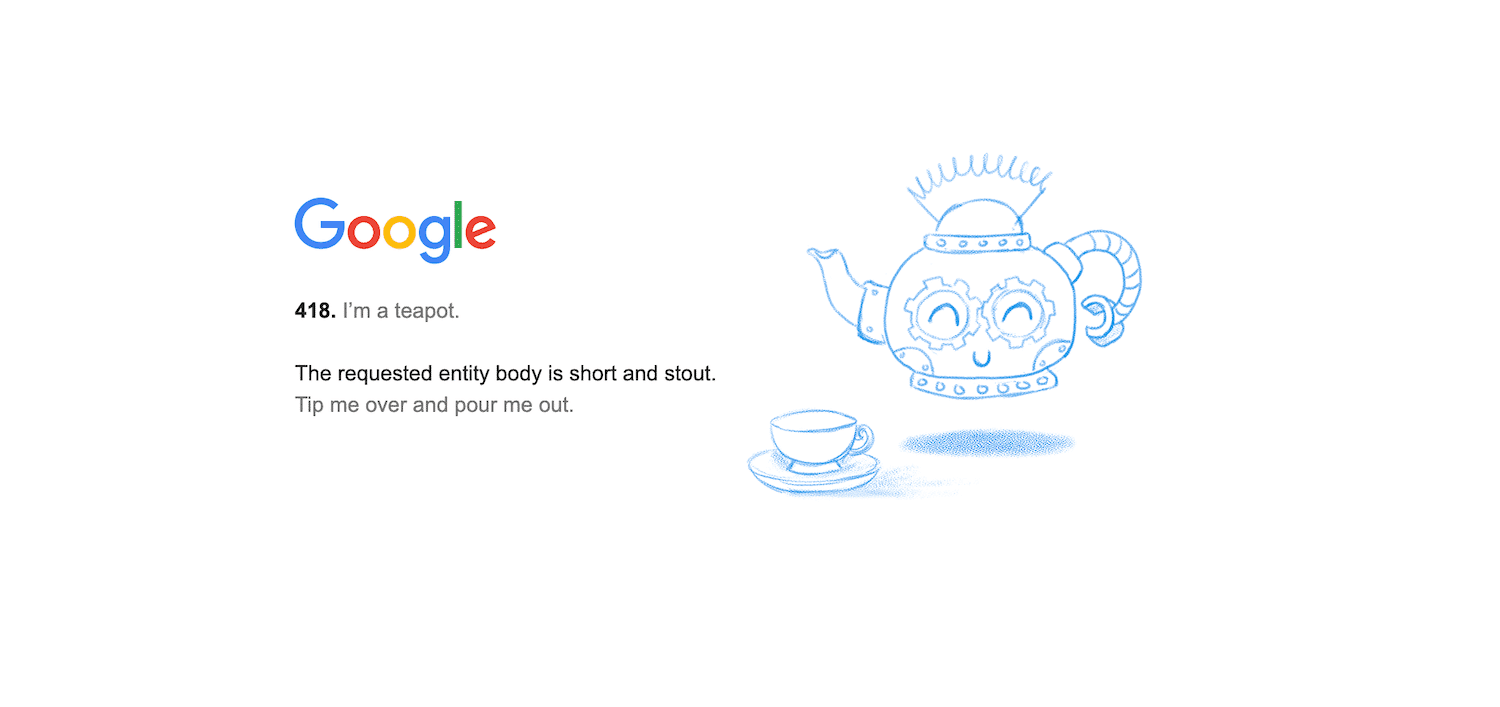
- 422: “Unprocessable Entity.” The client request contains semantic errors, and the server can’t process it.
- 425: “Too Early.” This code is sent when the server is unwilling to process a request because it may be replayed.
- 426: “Upgrade Required.” Due to the contents of the request’s upgrade header field, the client should switch to a different protocol.
- 428: “Precondition Required.” The server requires conditions to be specified before processing the request.
- 429: “Too many requests.” This is generated by the server when the user has sent too many requests in a given amount of time (rate-limiting). This can sometimes occur due to bots or scripts attempting to access your site. In this case, you might want to try changing your WordPress login URL. You can also check out our guide to fixing a 429 “Too Many Requests” error.

- 431: “Request Header Fields Too Large.” The server can’t process the request because the header fields are too large. This may indicate a problem with a single header field, or all of them collectively.
- 451: “Unavailable for Legal Reasons.” The operator of the server has received a demand to prohibit access to the resource you’ve requested (or a set of resources including the one you’ve requested). Fun fact: This code is a reference to Ray Bradbury’s novel Fahrenheit 451.
- 499: “Client closed request.” This is returned by NGINX when the client closes the request while Nginx is still processing it.
500 Status Codes
500-level status codes are also considered errors. However, they denote that the problem is on the server’s end. This can make them more difficult to resolve.
- 500: “There was an error on the server and the request could not be completed.” This is generic code that simply means “internal server error”. Something went wrong on the server and the requested resource was not delivered. This code is typically generated by third-party plugins, faulty PHP, or even the connection to the database breaking. Check out our tutorials on how to fix the error establishing a database connection and other ways to resolve a 500 internal server error.

- 501: “Not Implemented.” This error indicates that the server does not support the functionality required to fulfill the request. This is almost always a problem on the web server itself, and usually must be resolved by the host. Check out our recommendations on how to resolve a 501 not implemented error.
- 502: “Bad Gateway.” This error code typically means that one server has received an invalid response from another, such as when a proxy server is in use. Other times a query or request will take too long, and so it is canceled or killed by the server and the connection to the database breaks. For more details, see our in-depth tutorial on how to fix the 502 Bad Gateway error.
- 503: “The server is unavailable to handle this request right now.” The request cannot be completed at this point in time. This code may be returned by an overloaded server that is unable to handle additional requests. We have a full guide on how to fix the 503 Service Unavailable Error.
- 504: “The server, acting as a gateway, timed out waiting for another server to respond.” This is the code returned when there are two servers involved in processing a request, and the first server times out waiting for the second server to respond. You can read more about how to fix 504 errors in our dedicated guide.
- 505: “HTTP Version Not Supported.” The server doesn’t support the HTTP version the client used to make the request.
- 508: “Resource Limit Is Reached” limits on resources set by your web host have been reached. Check out our tutorial on how to resolve “508 Resource Limit Is Reached” error.
- 509: “Bandwidth Limit Exceeded” means your website is using more bandwidth than your hosting provider allows.
- 511: “Network Authentication Required.” This status code is sent when the network you’re trying to use requires some form of authentication before sending your request to the server. For instance, you may need to agree to the Terms and Conditions of a public Wi-Fi hotspot.
- 521: “Web server is down.” Error 521 is a Cloudflare-specific error message. It means that your web browser was able to successfully connect to Cloudflare, but Cloudflare was not able to connect to the origin web server.
- 525: “SSL Handshake Failed“. Error 525 means that the SSL handshake between a domain using Cloudflare and the origin web server failed. If you are experiencing issues there are five methods you can try to easily fix error 525.
Where to Learn More About HTTP Status Codes
In addition to the HTTP status codes we’ve covered in this list, there are some more obscure ones you may want to learn about. There are several resources you can consult to read up on these rarer codes, including:
- This comprehensive list of HTTP status codes from Wikipedia.
- Status code definitions from the Internet Engineering Task Force (IETF).
- RFC 7231.
Knowing these status codes may help you resolve some unique issues while maintaining your own website, or even when you encounter them on other sites.
They might seem intimidating at first, but HTTP status codes are important to understand what’s happening on your site. Here’s a thorough list of those you should get familiar with! 📟🌐Click to Tweet
Summary
While they may seem confusing or intimidating on the surface, HTTP status codes are actually very informative. By learning some of the common ones, you can troubleshoot problems on your site more quickly.
In this post, we’ve defined 40+ HTTP status codes that you may encounter. From the milder 100- and 200-level codes to the trickier 400- and 500-level errors, making sense of these messages is crucial for maintaining your website and making sure it’s accessible to users.
